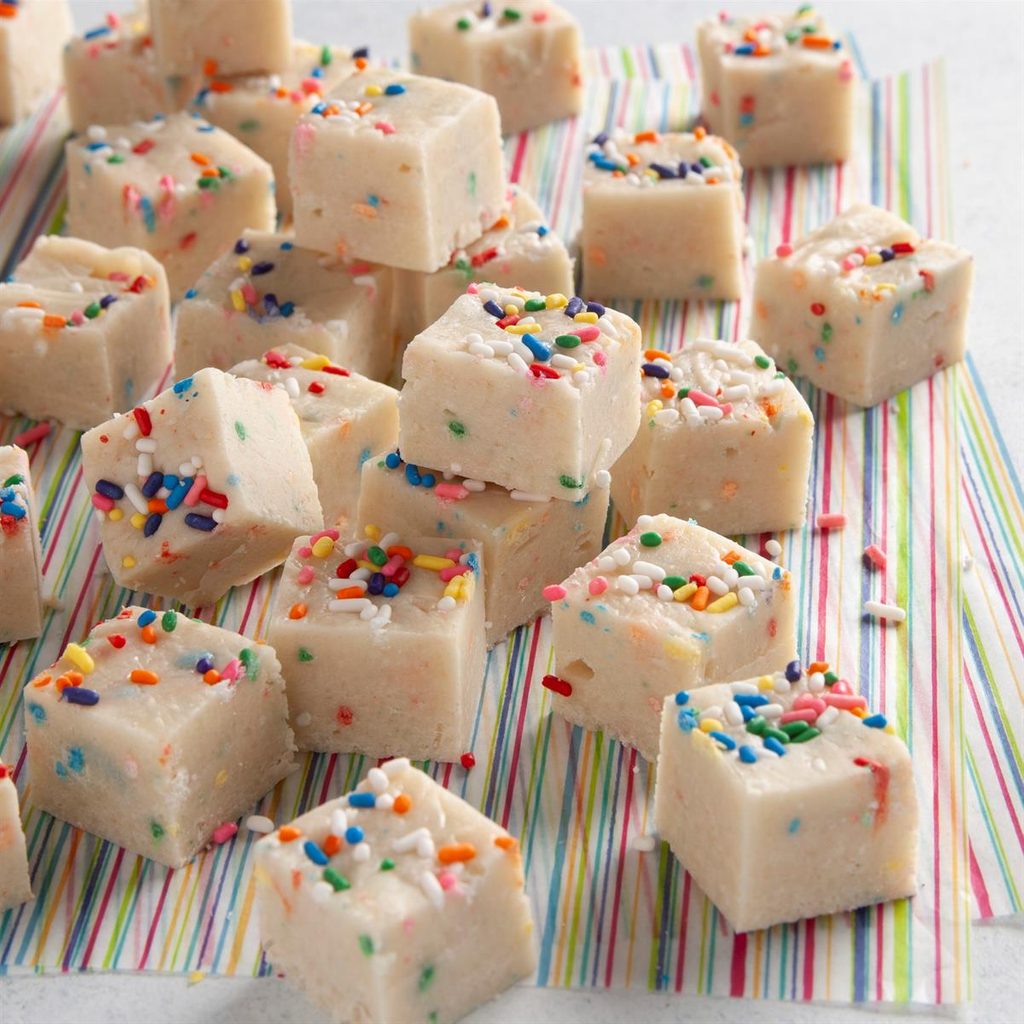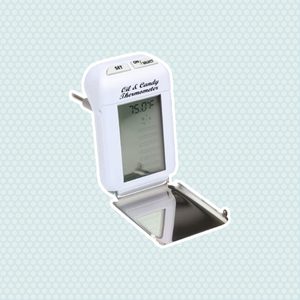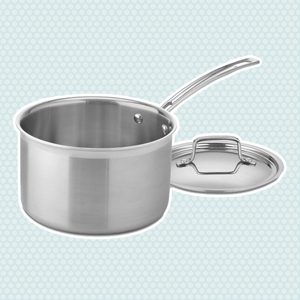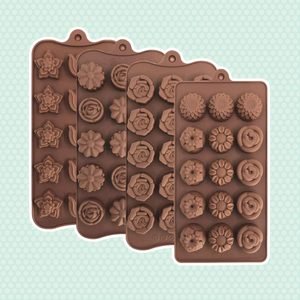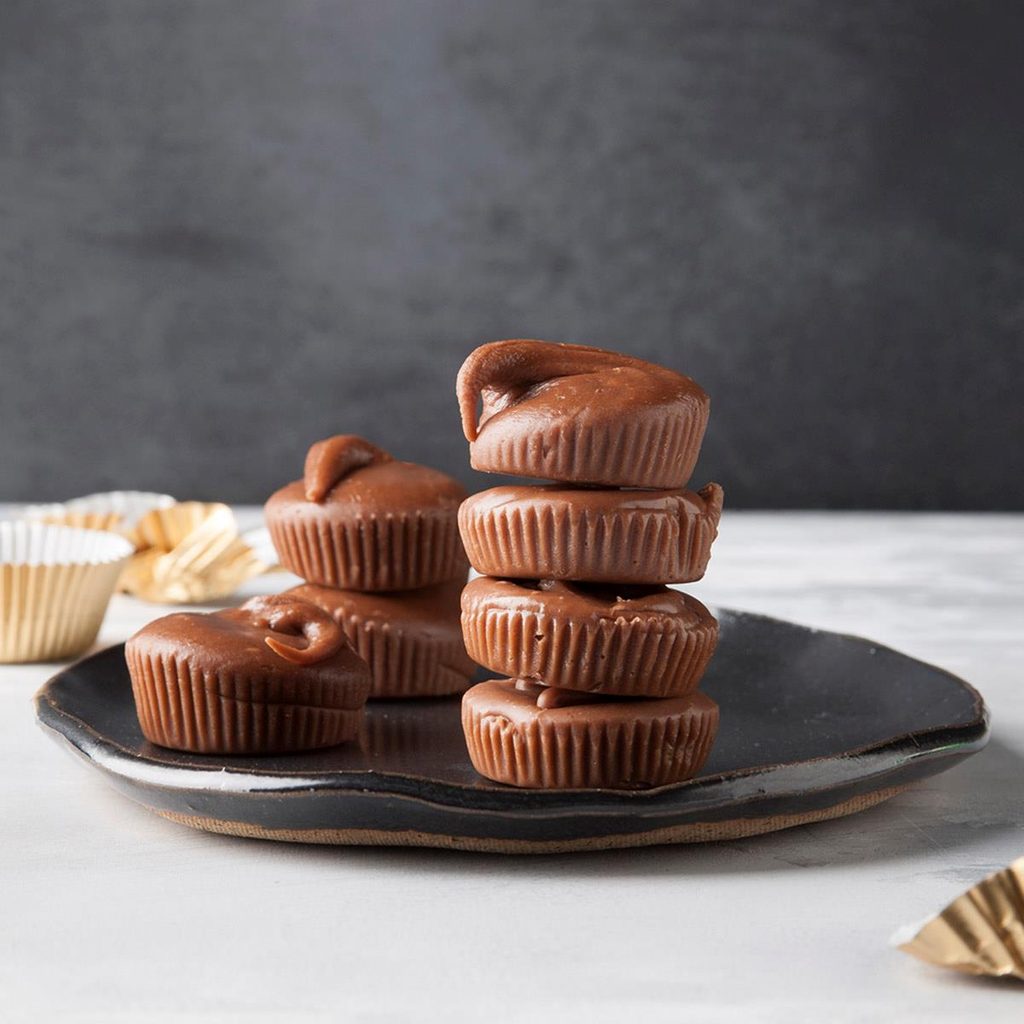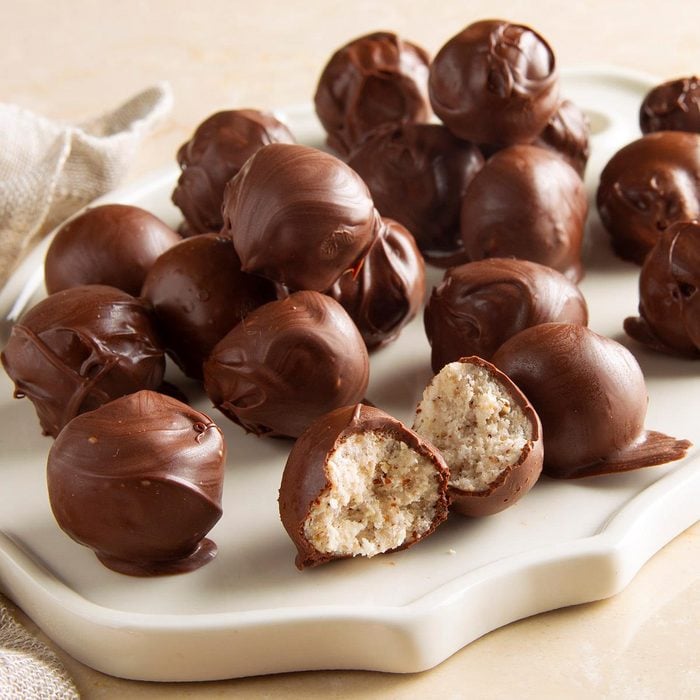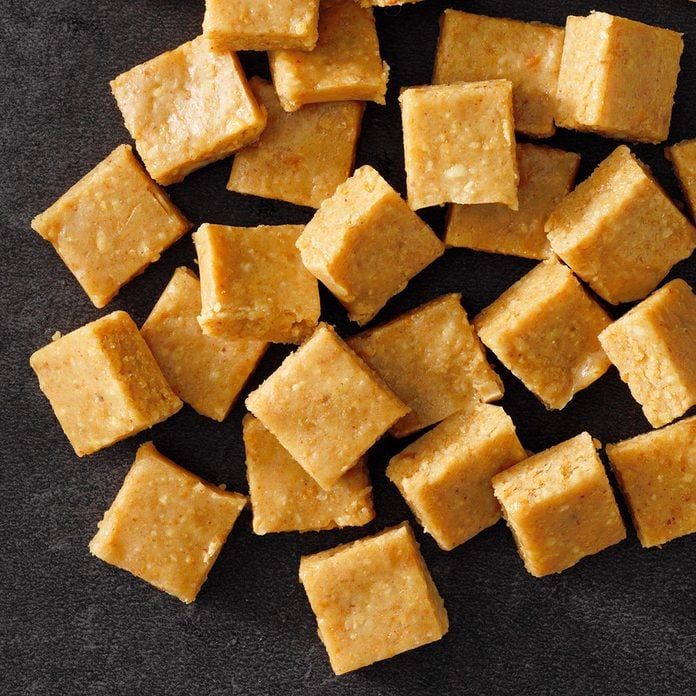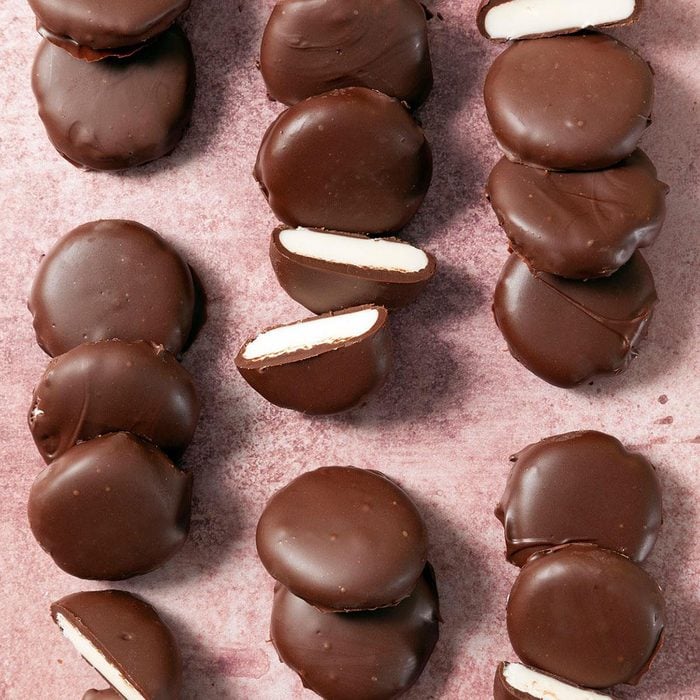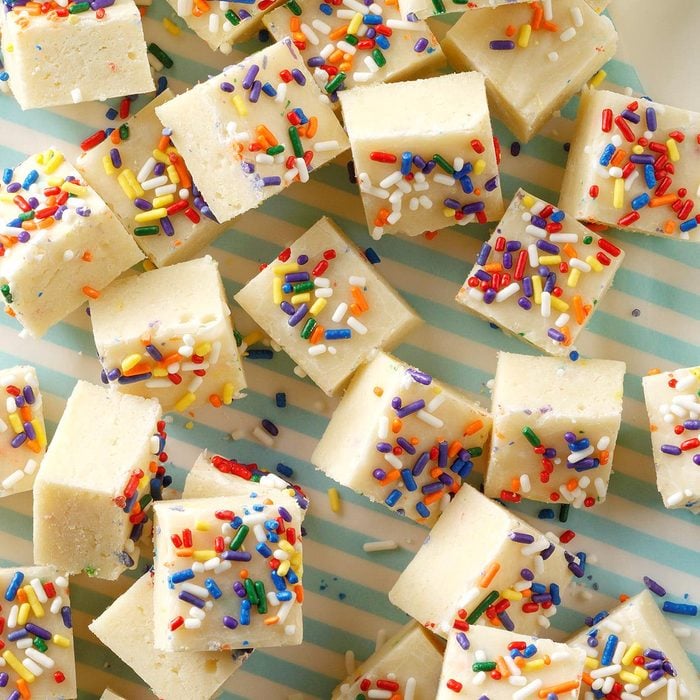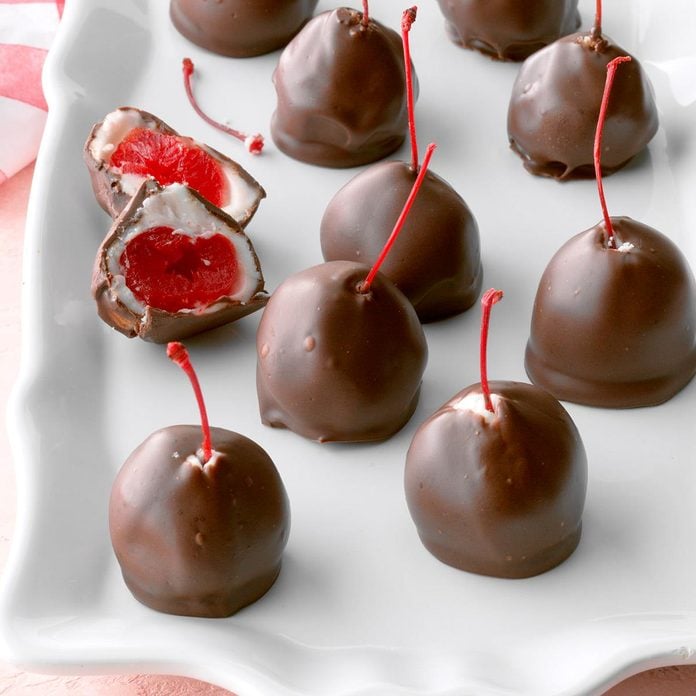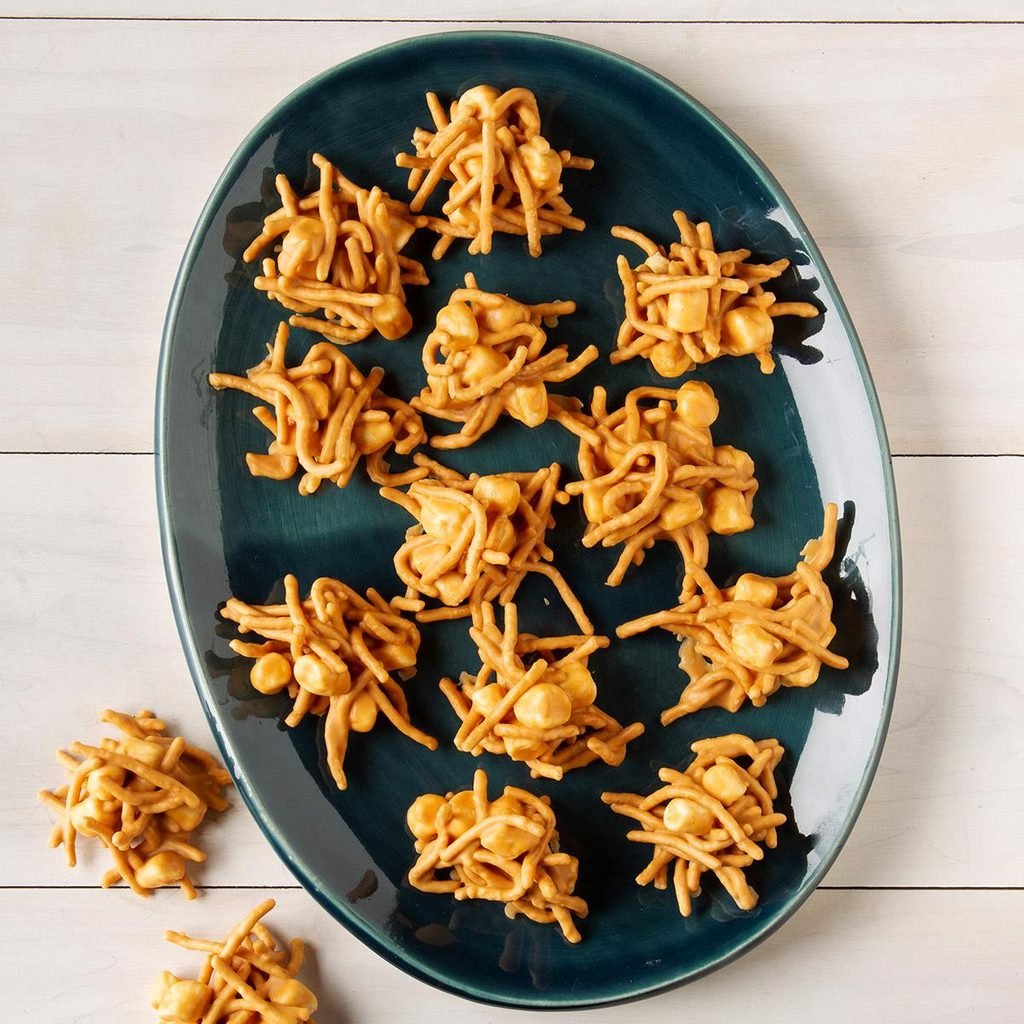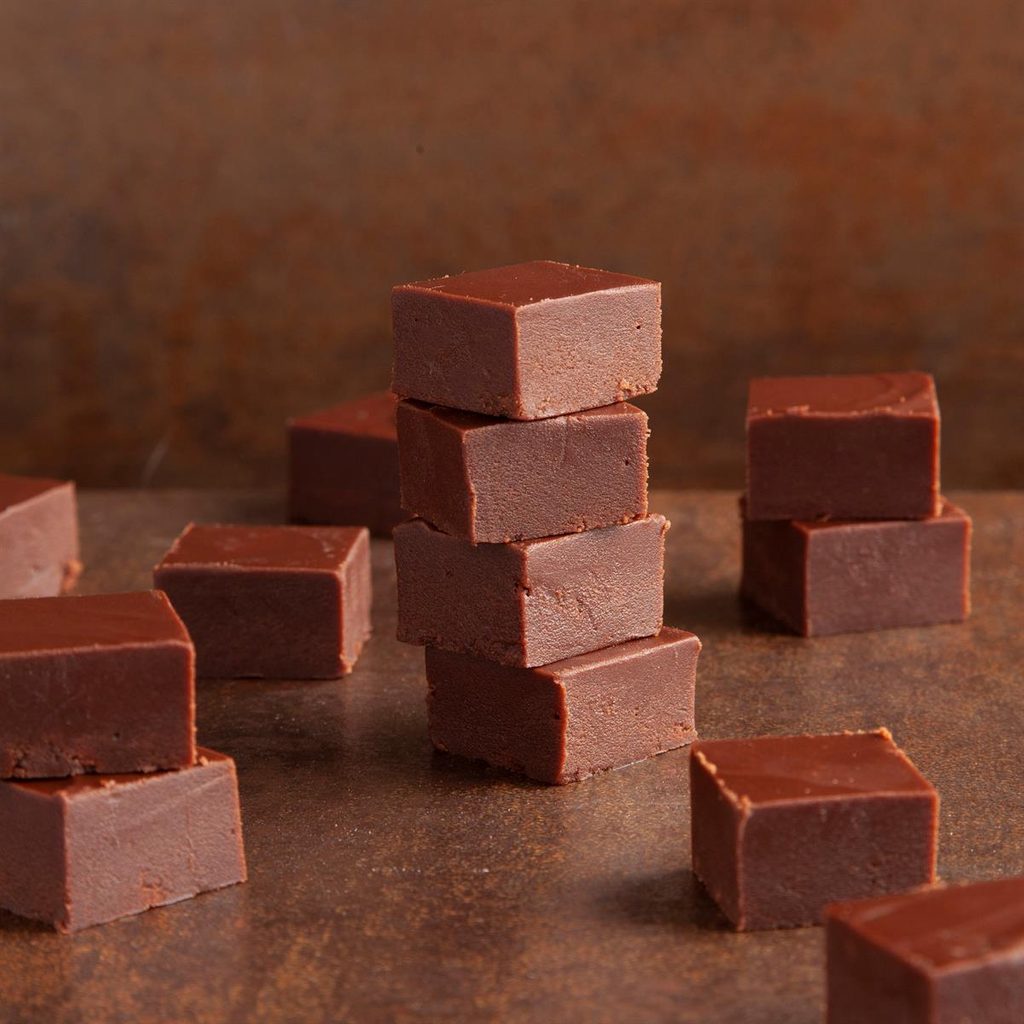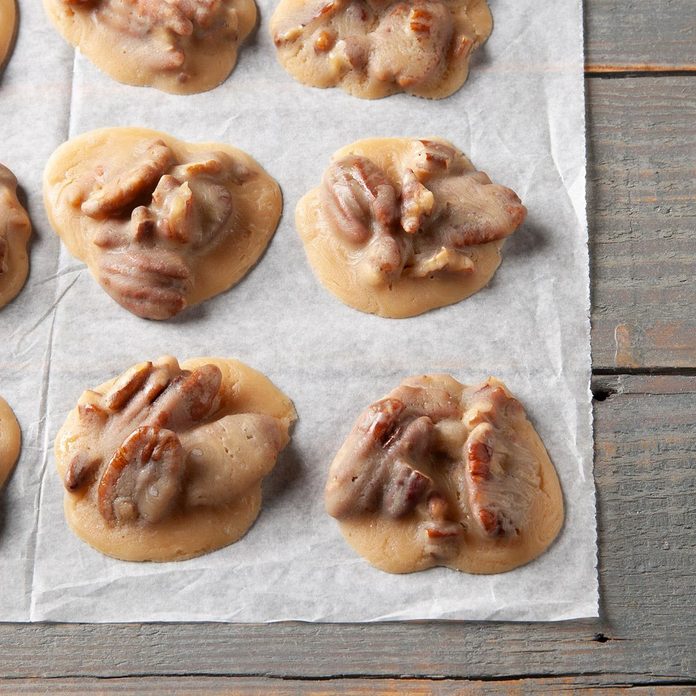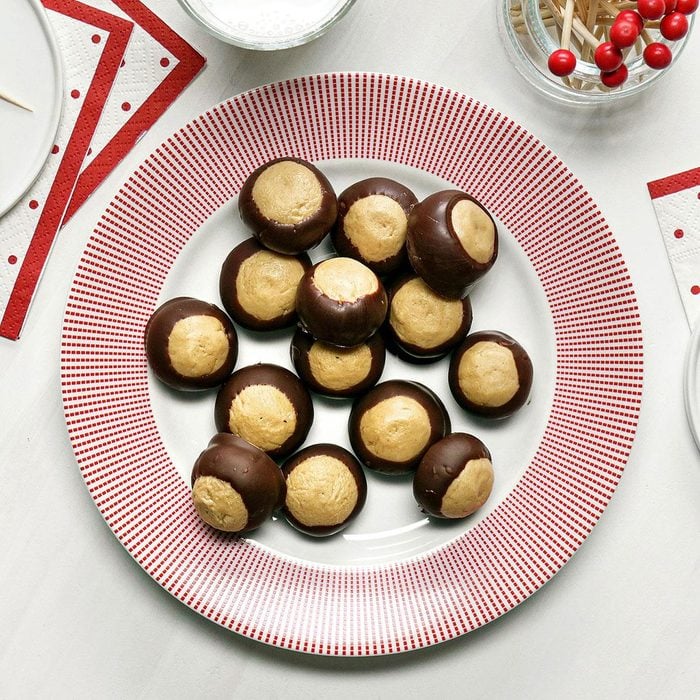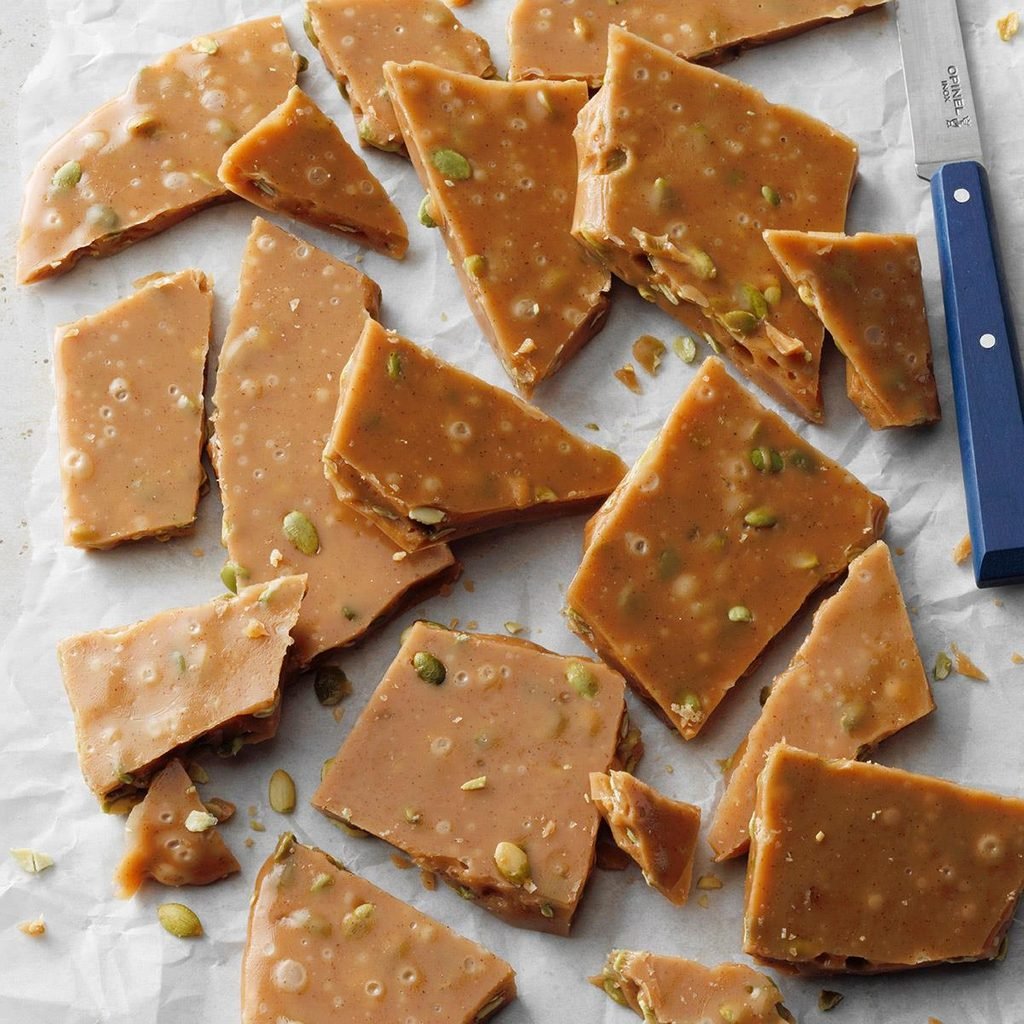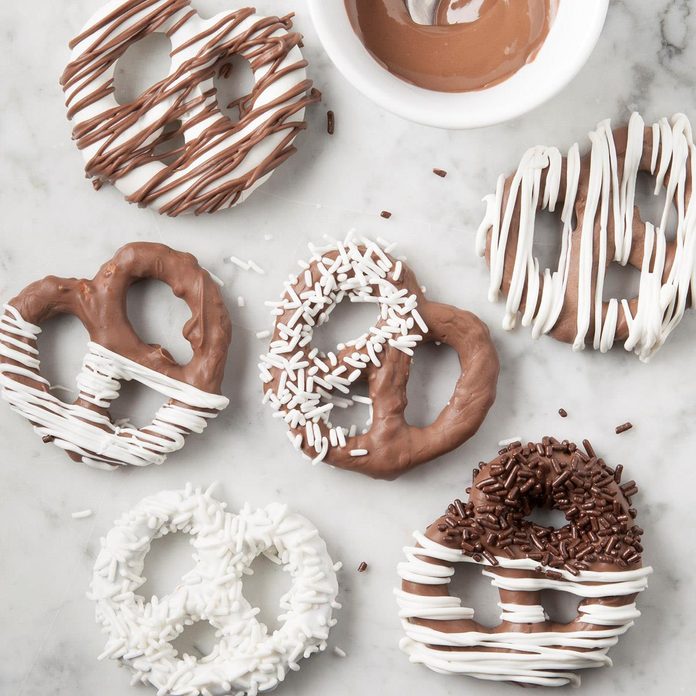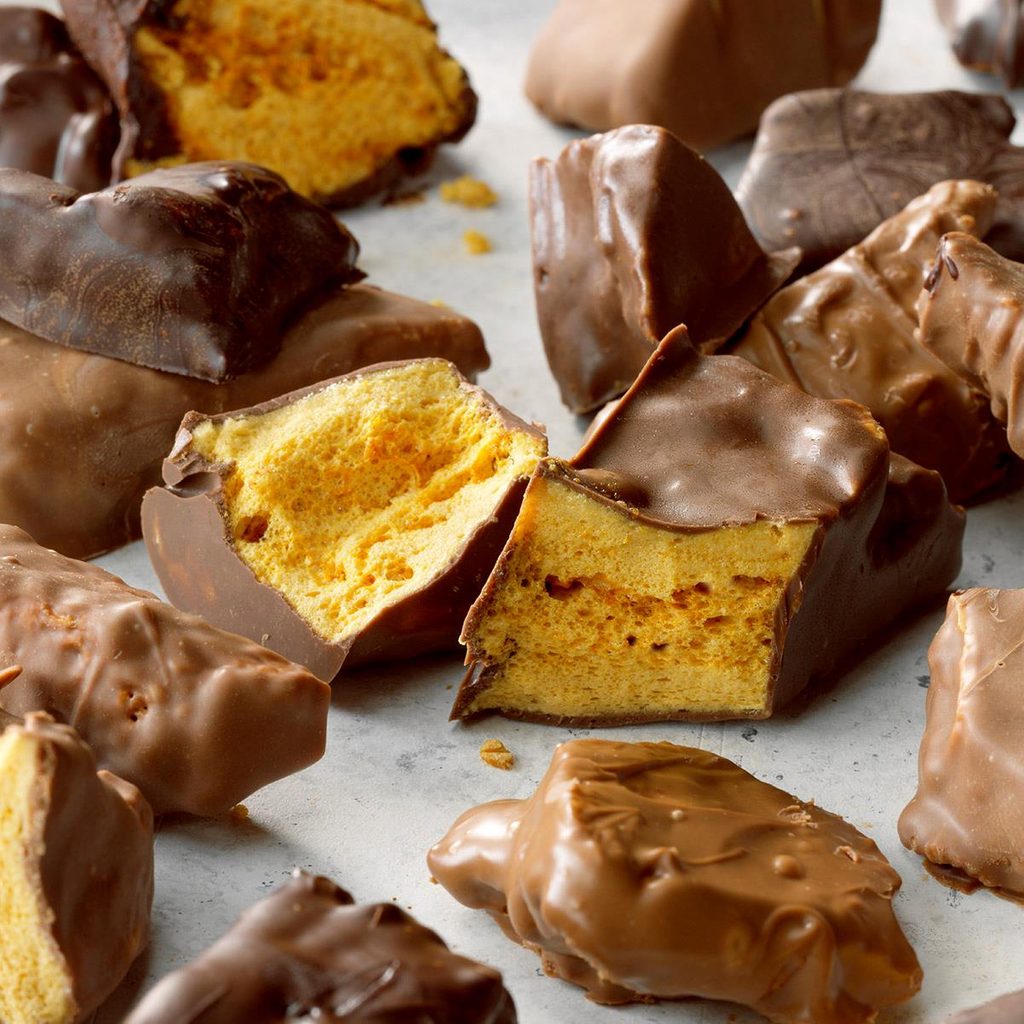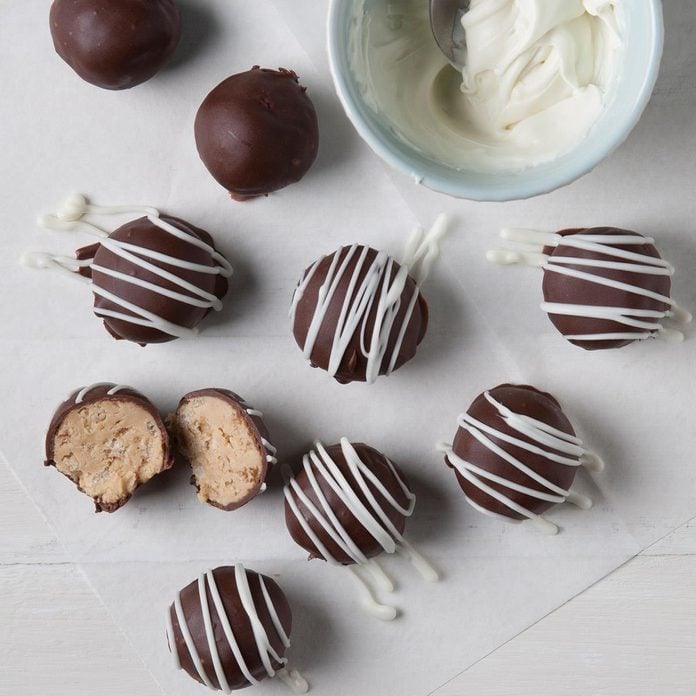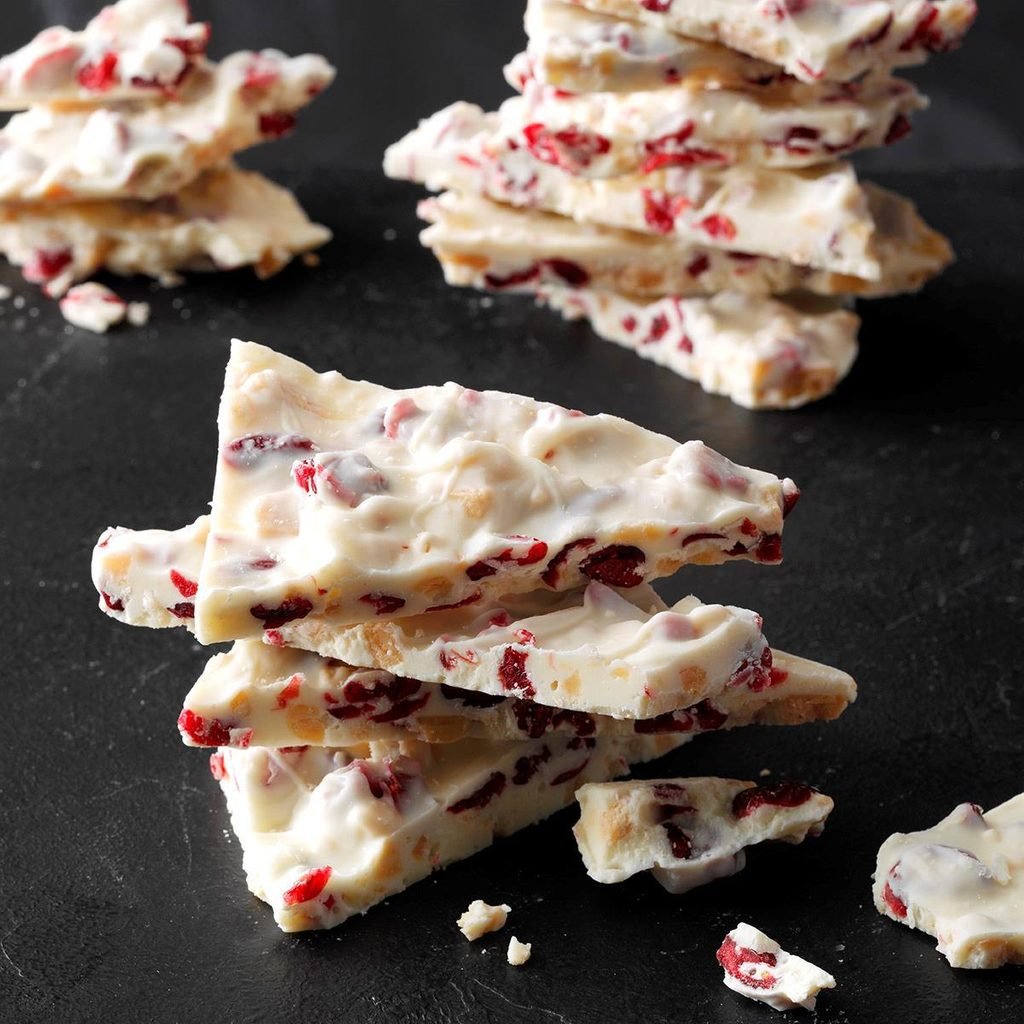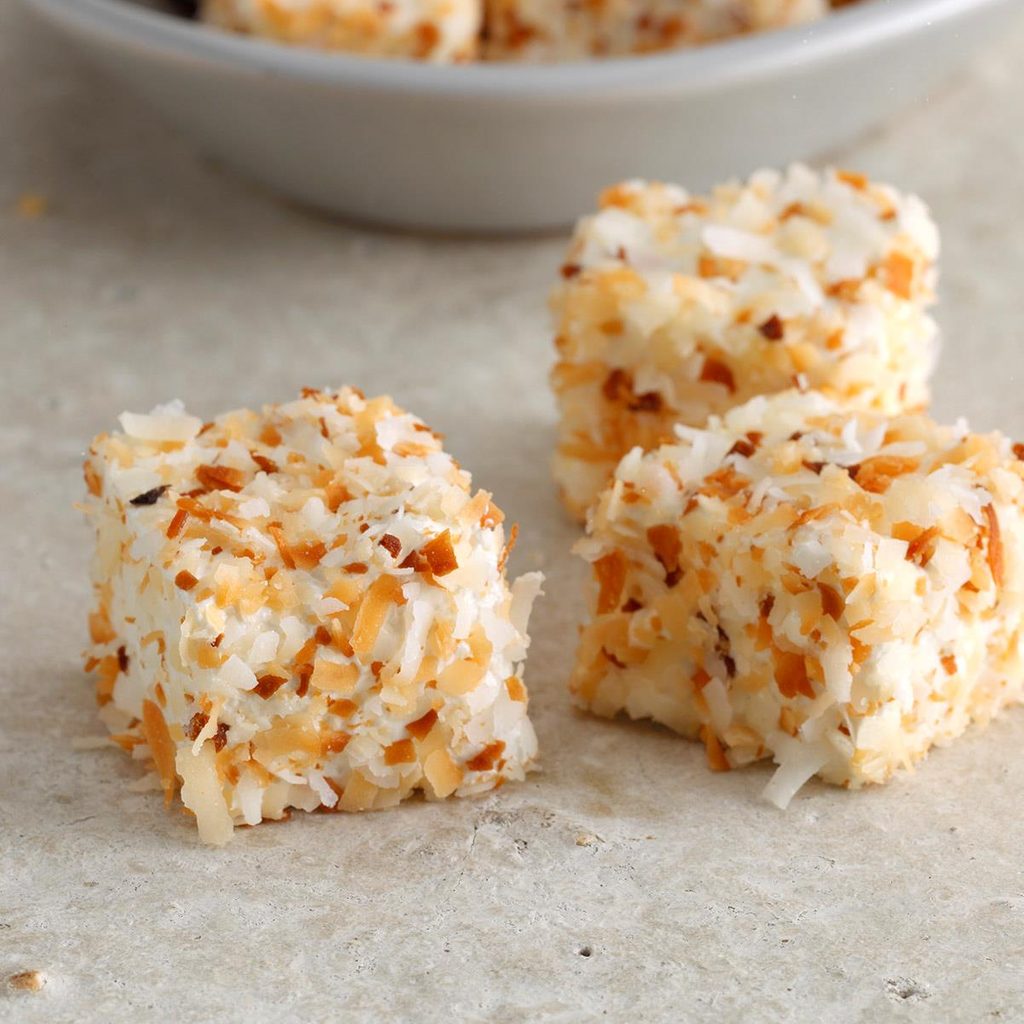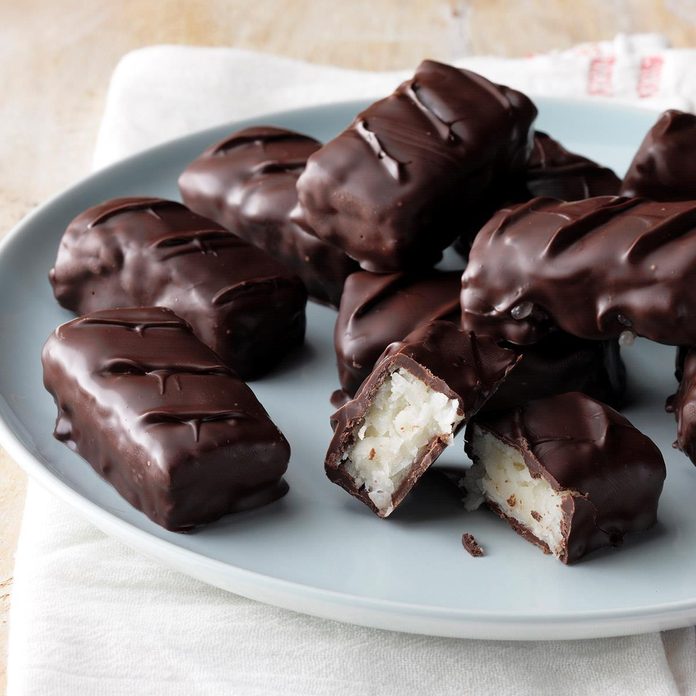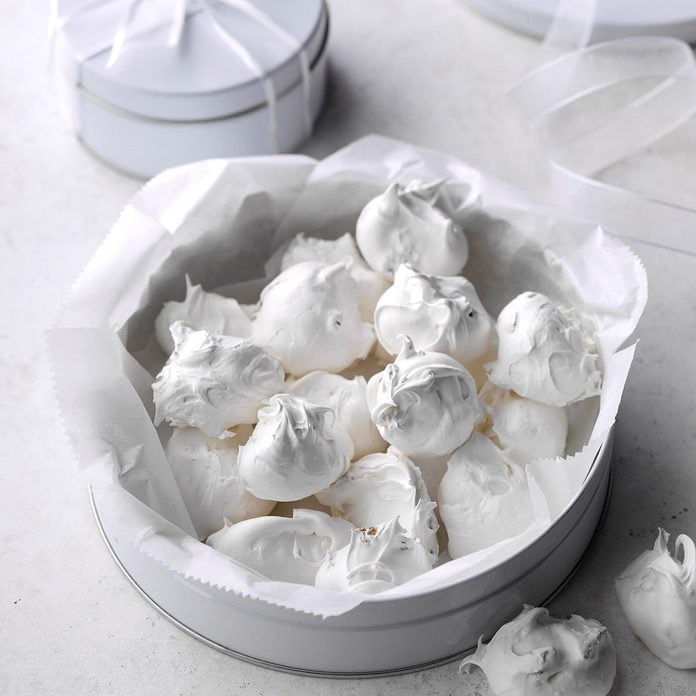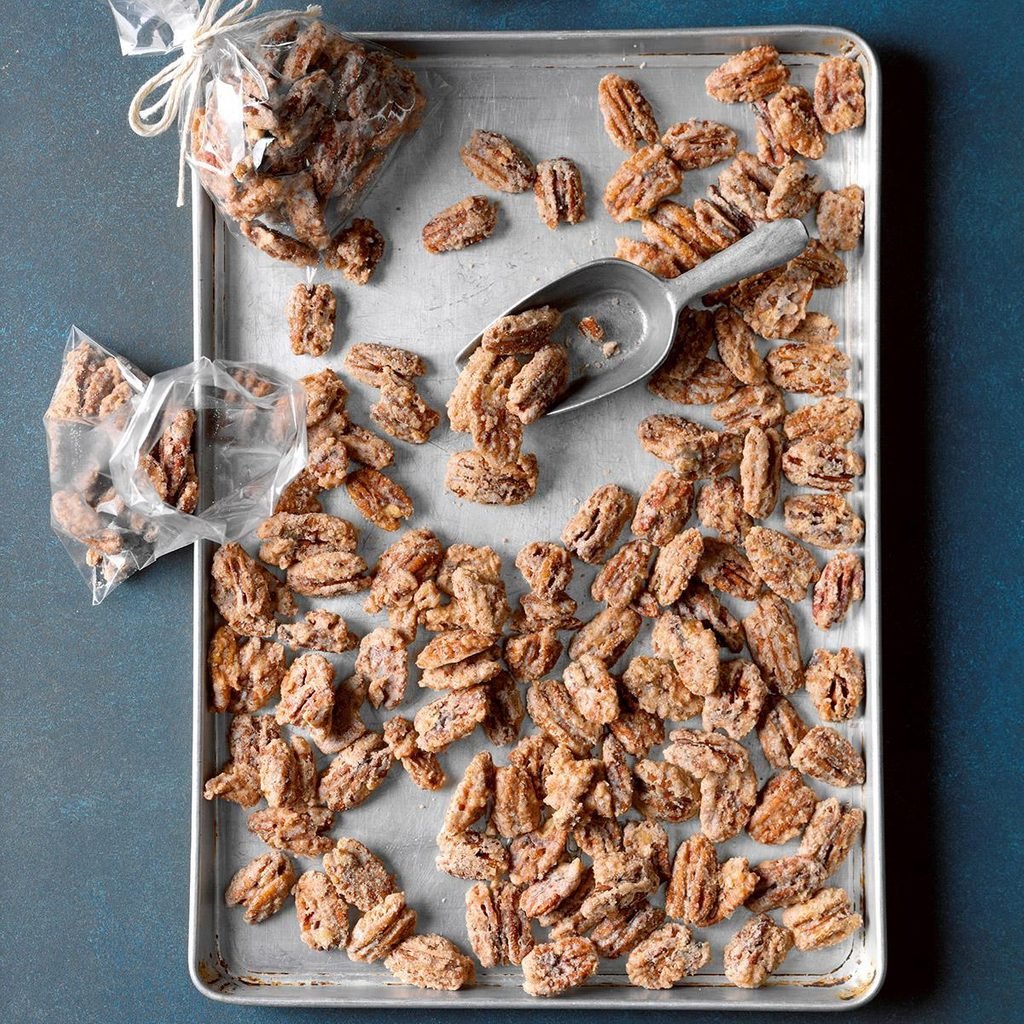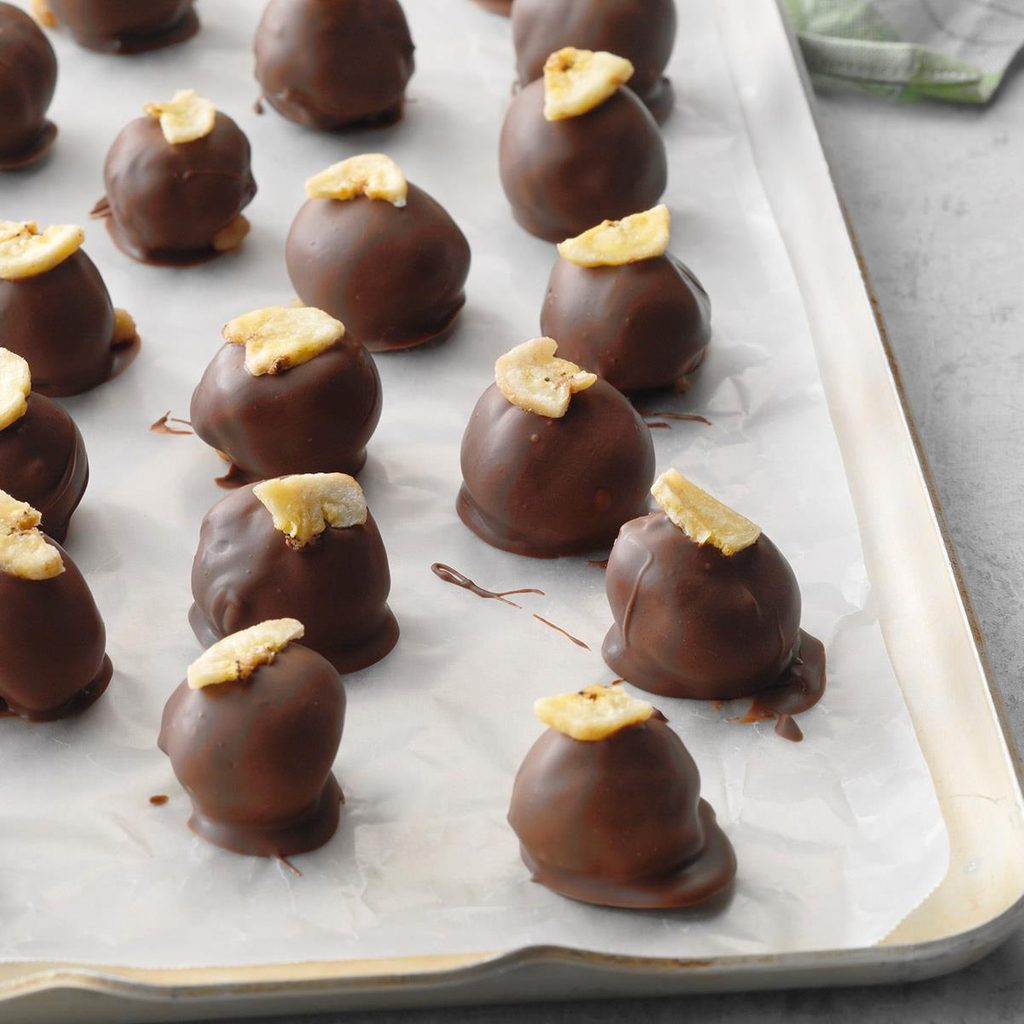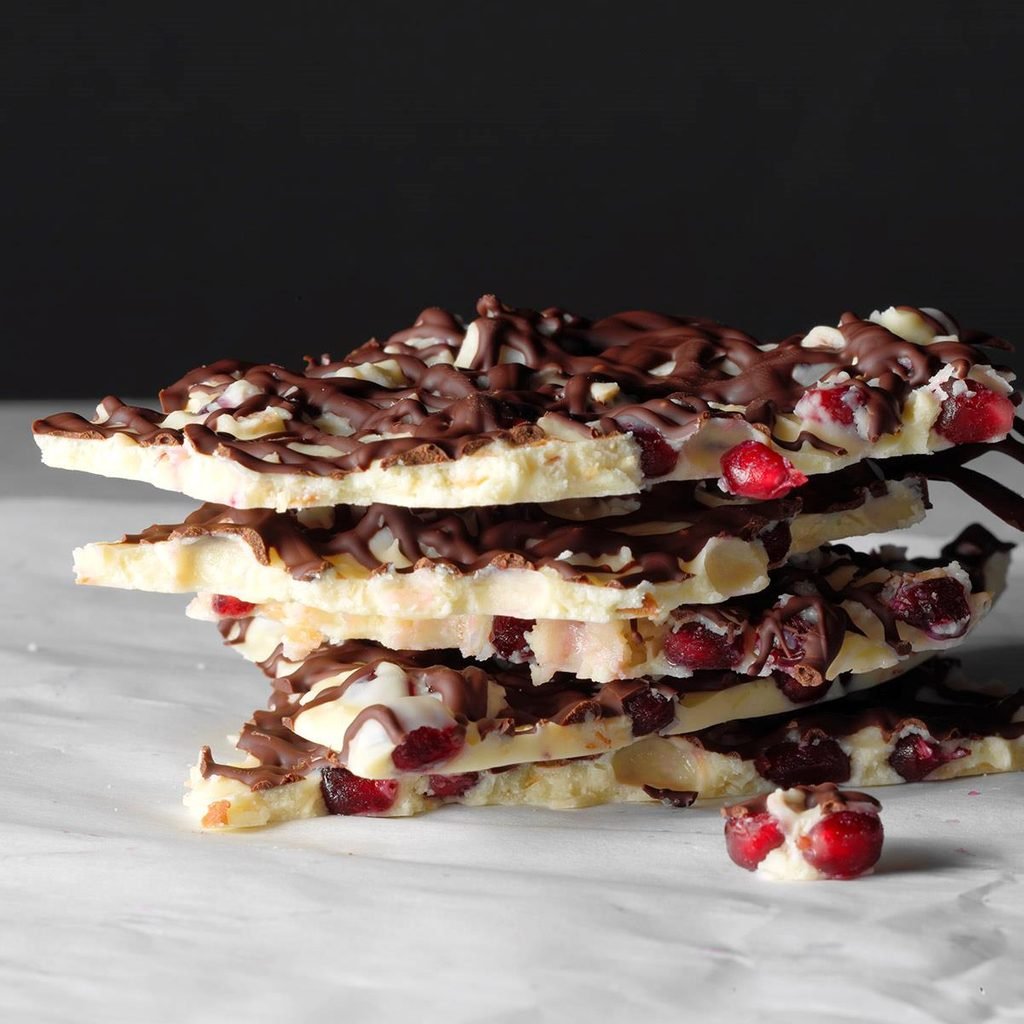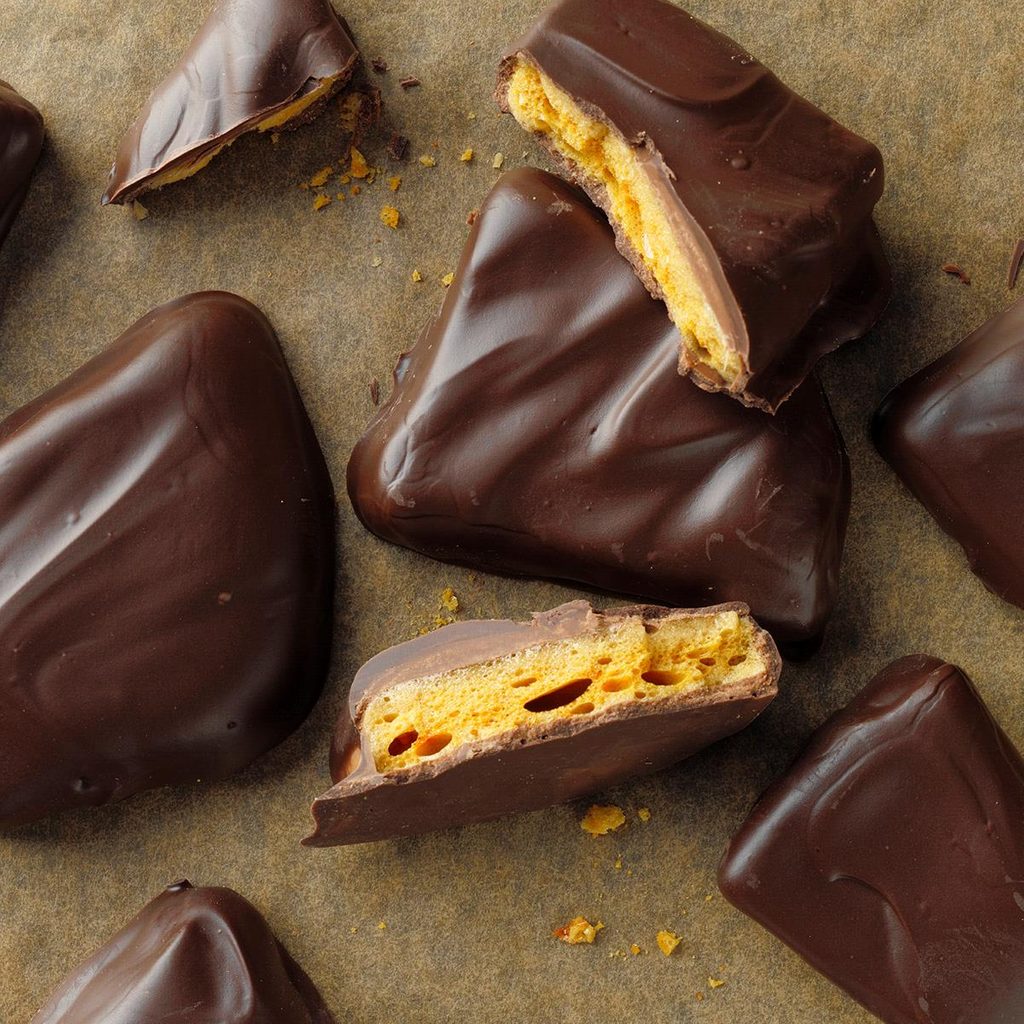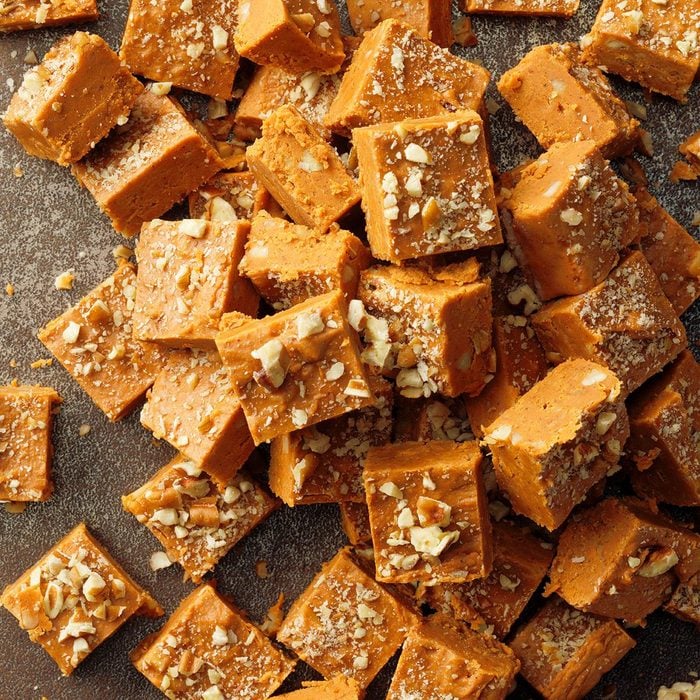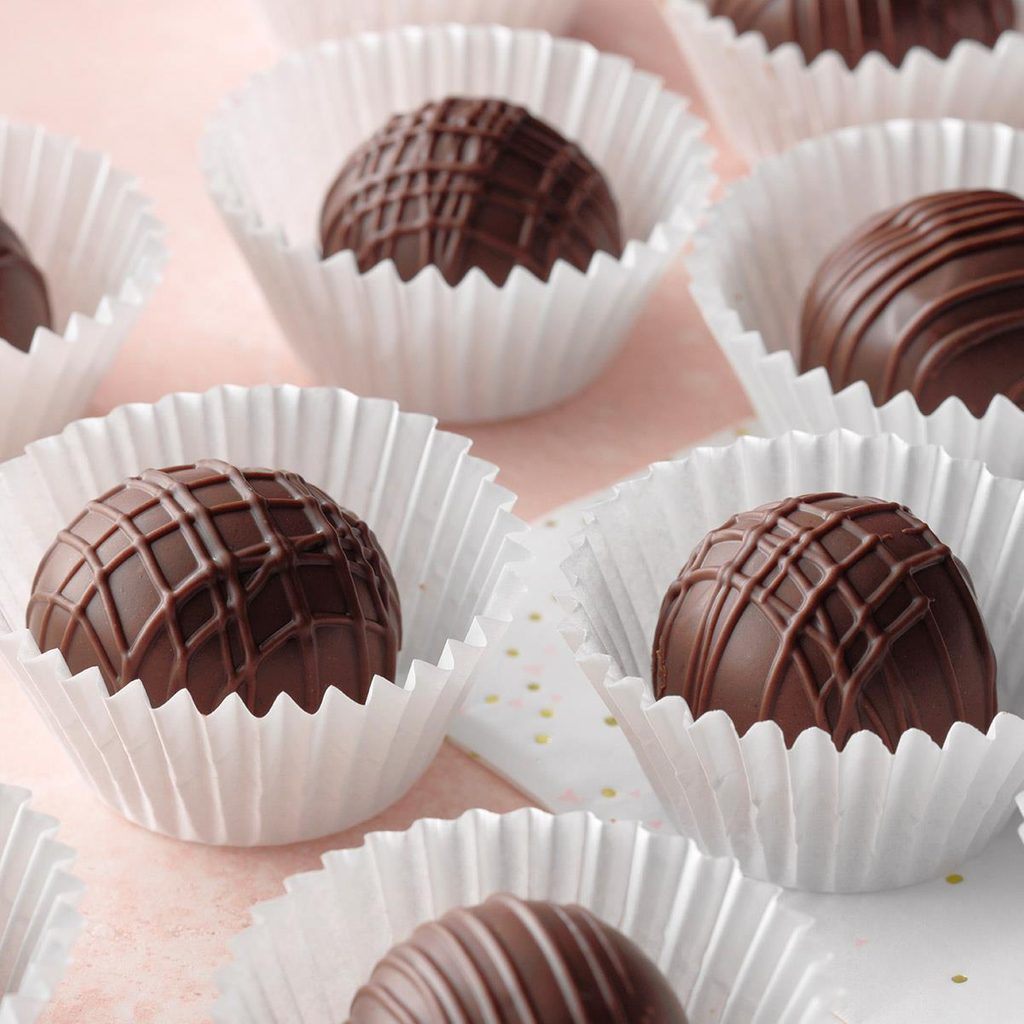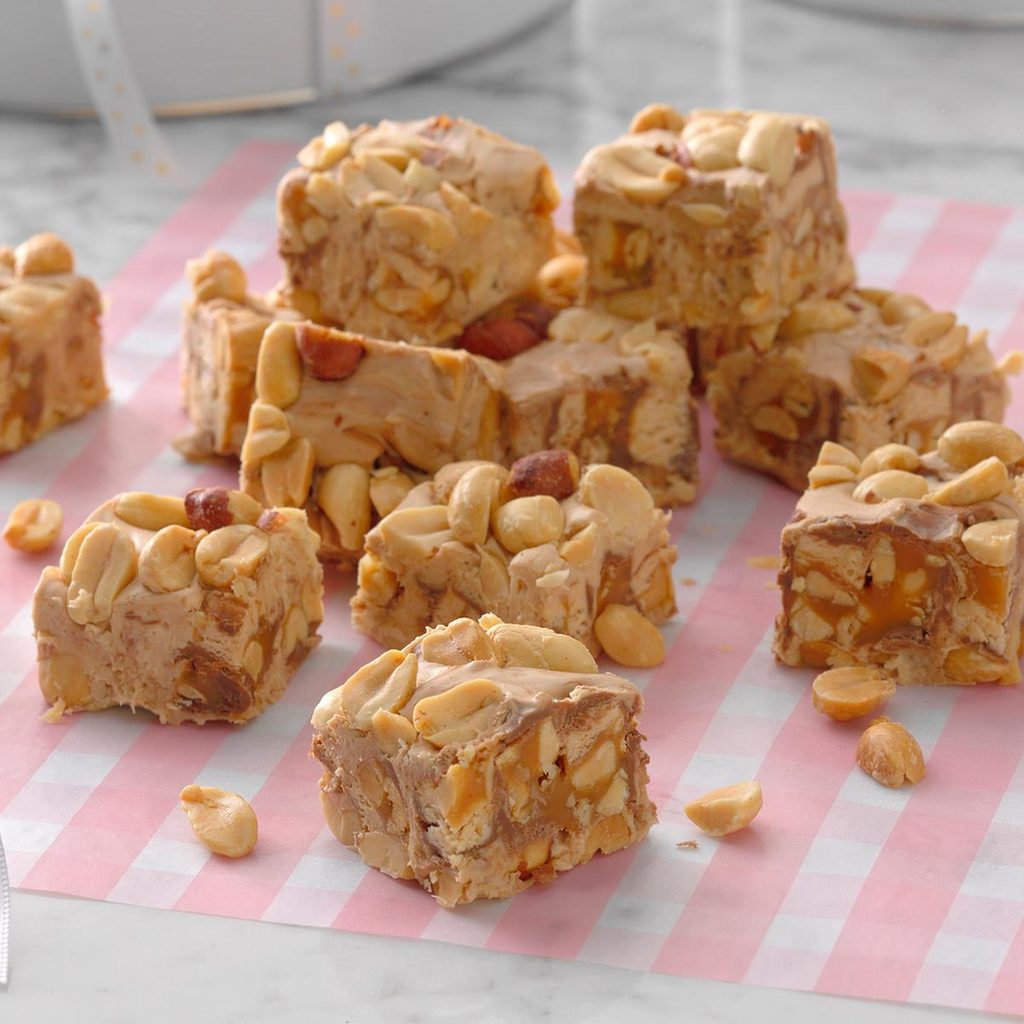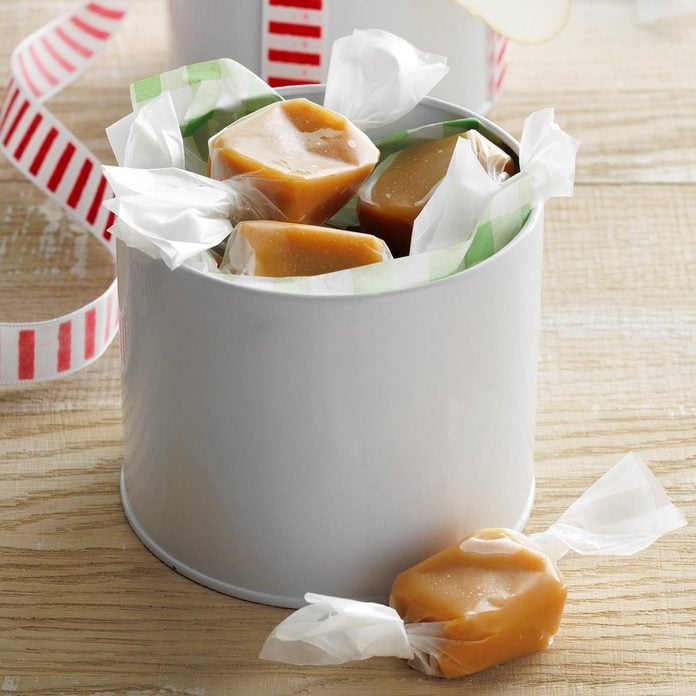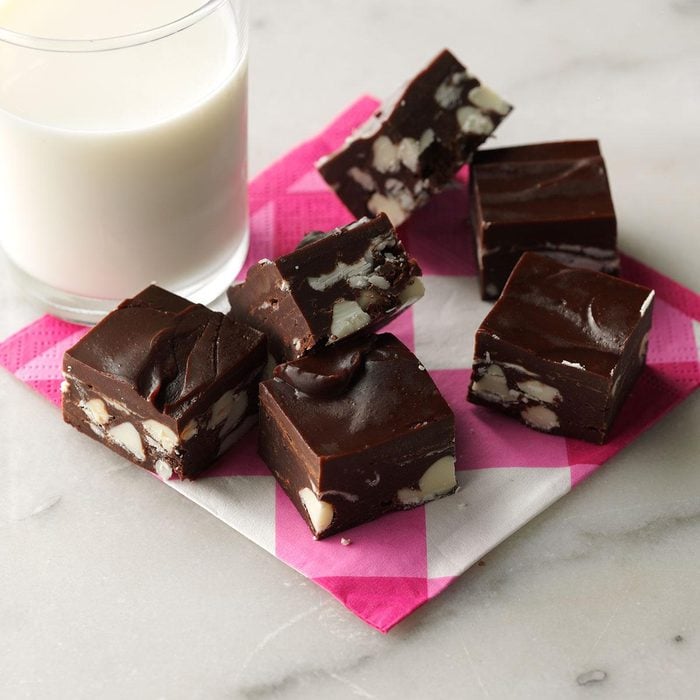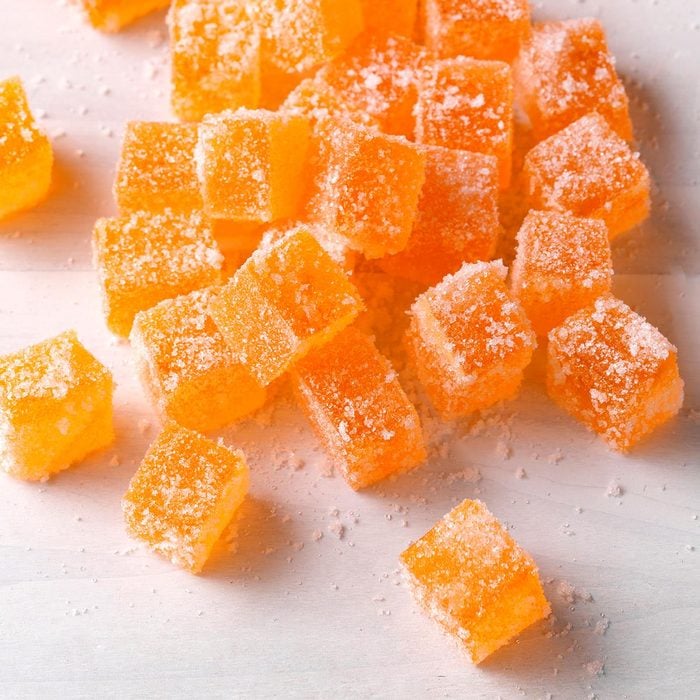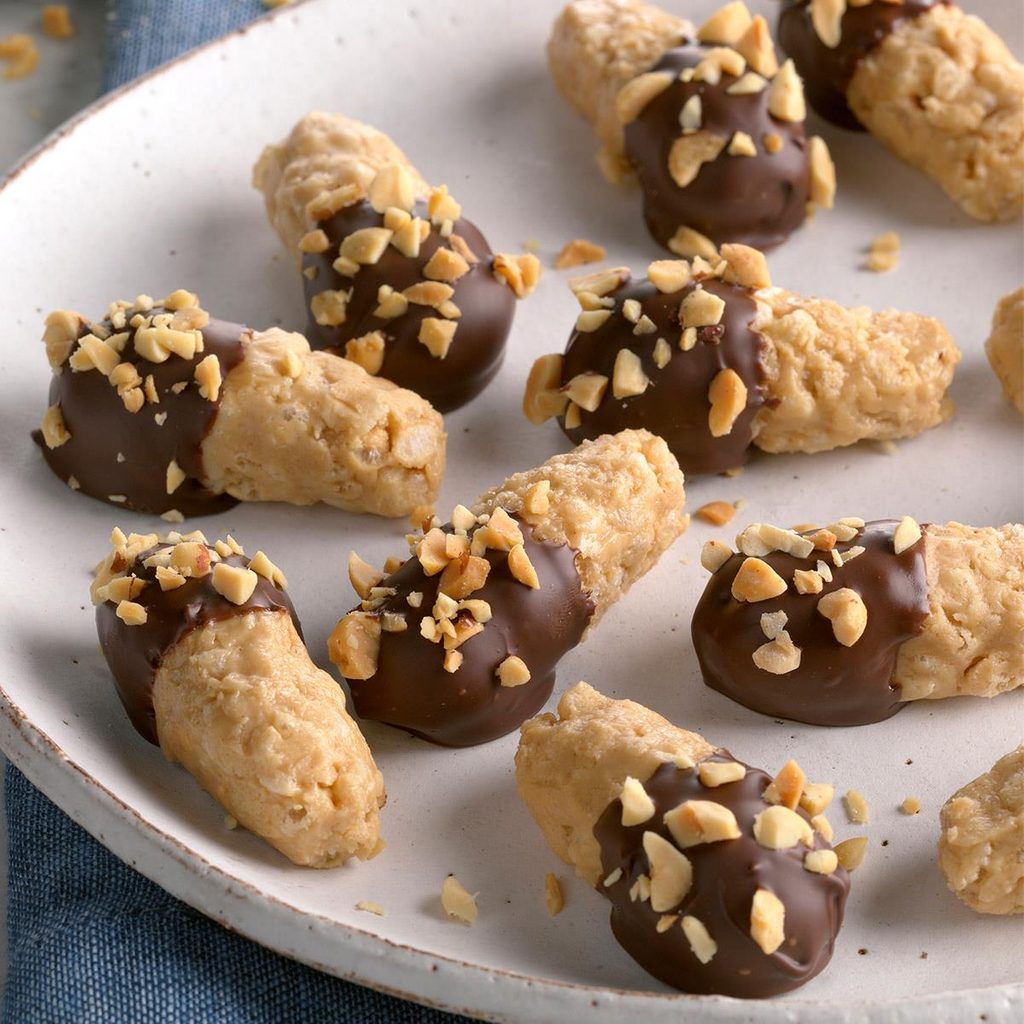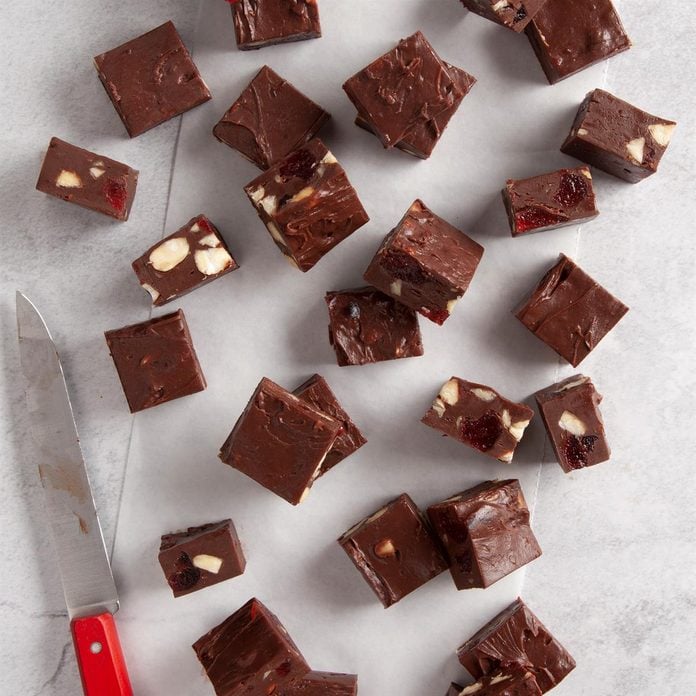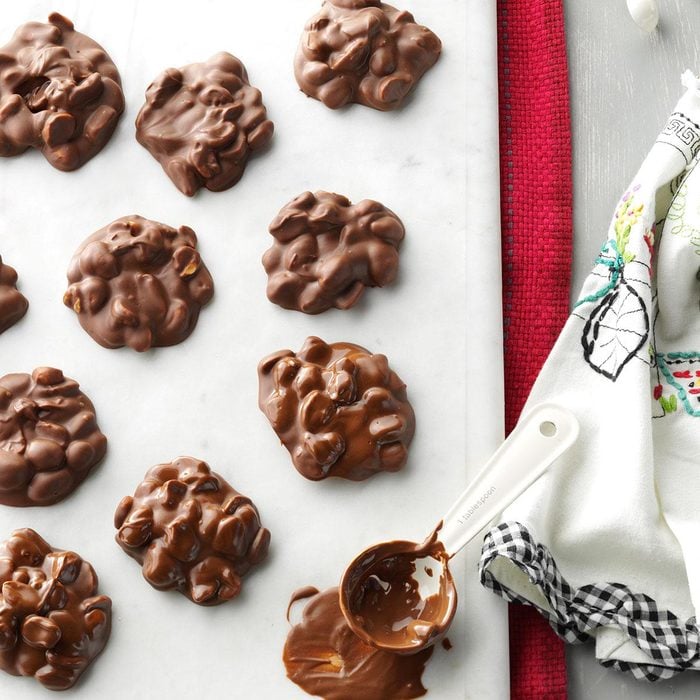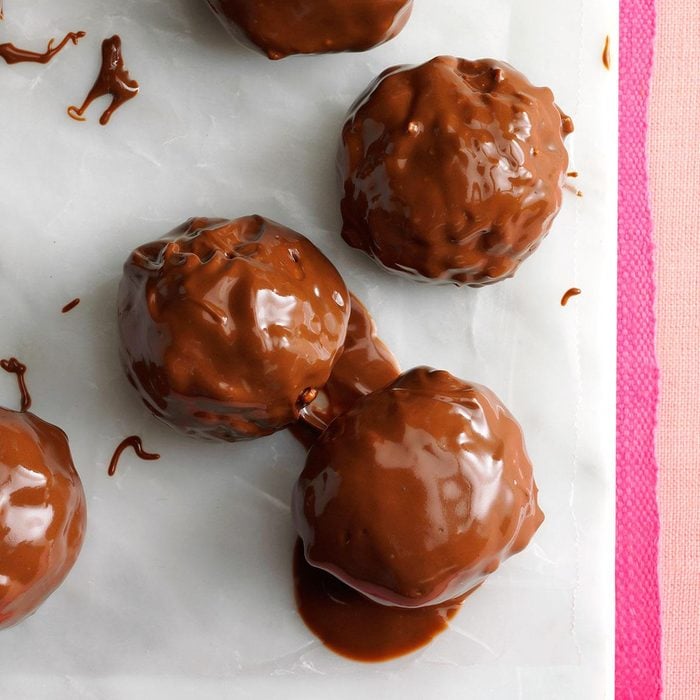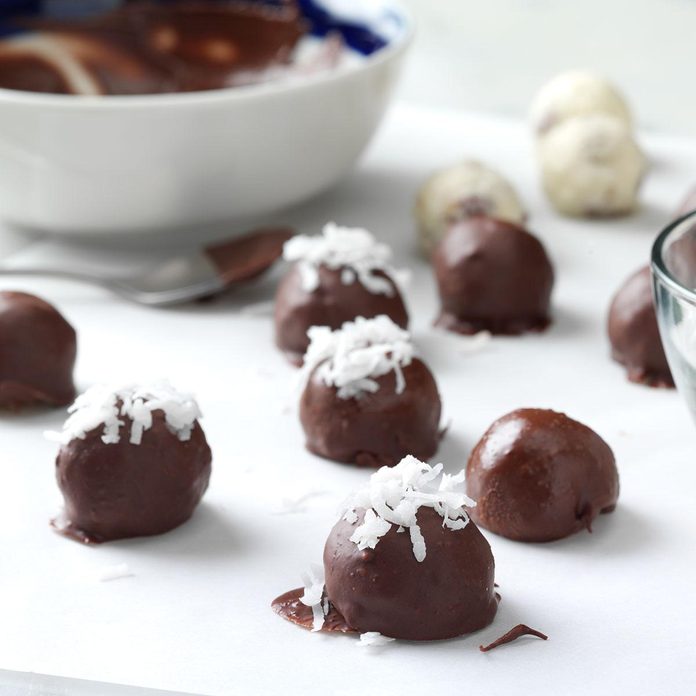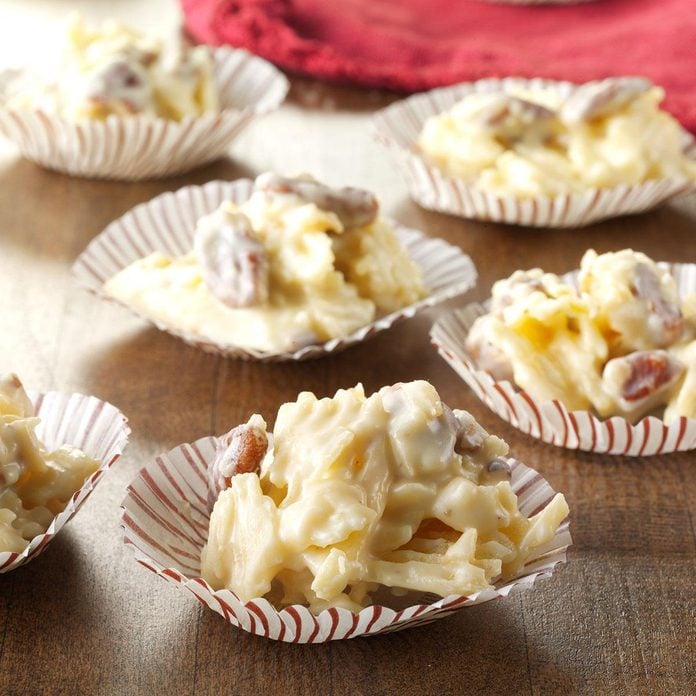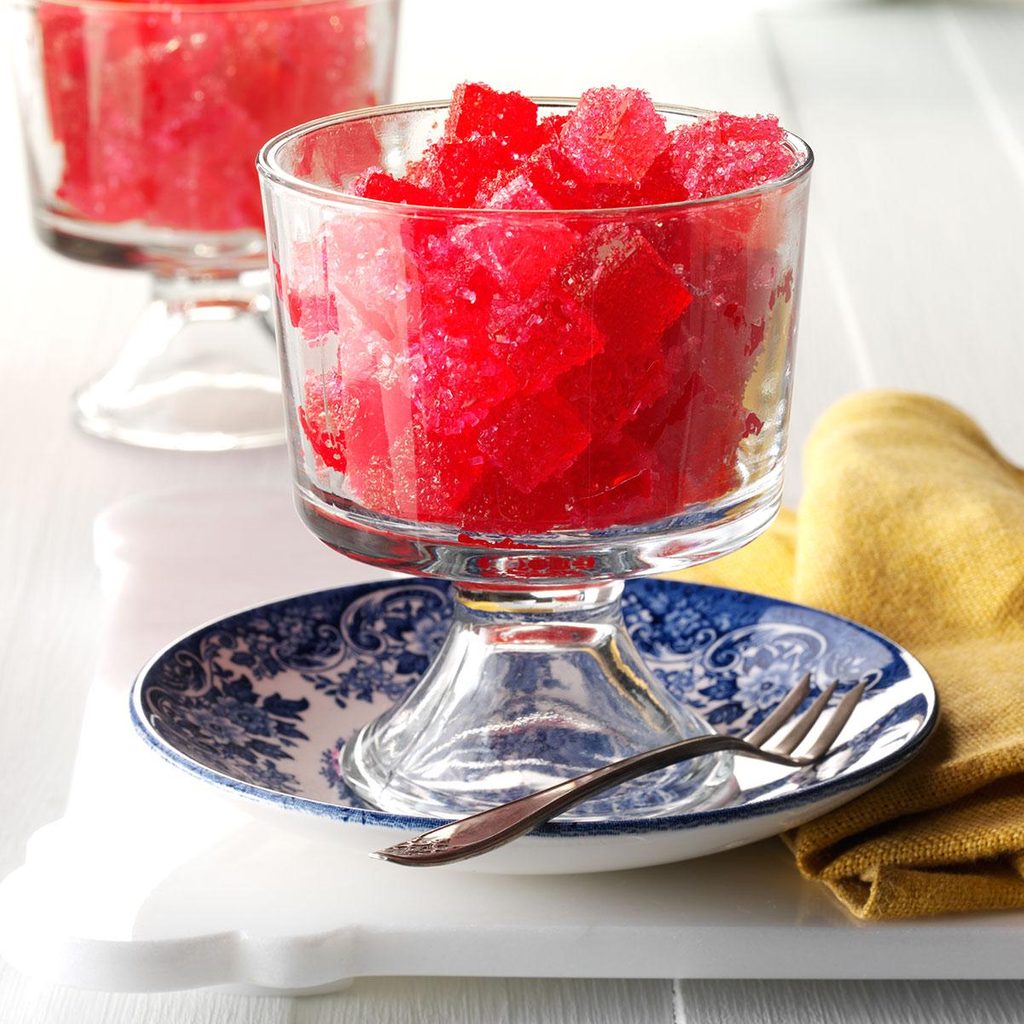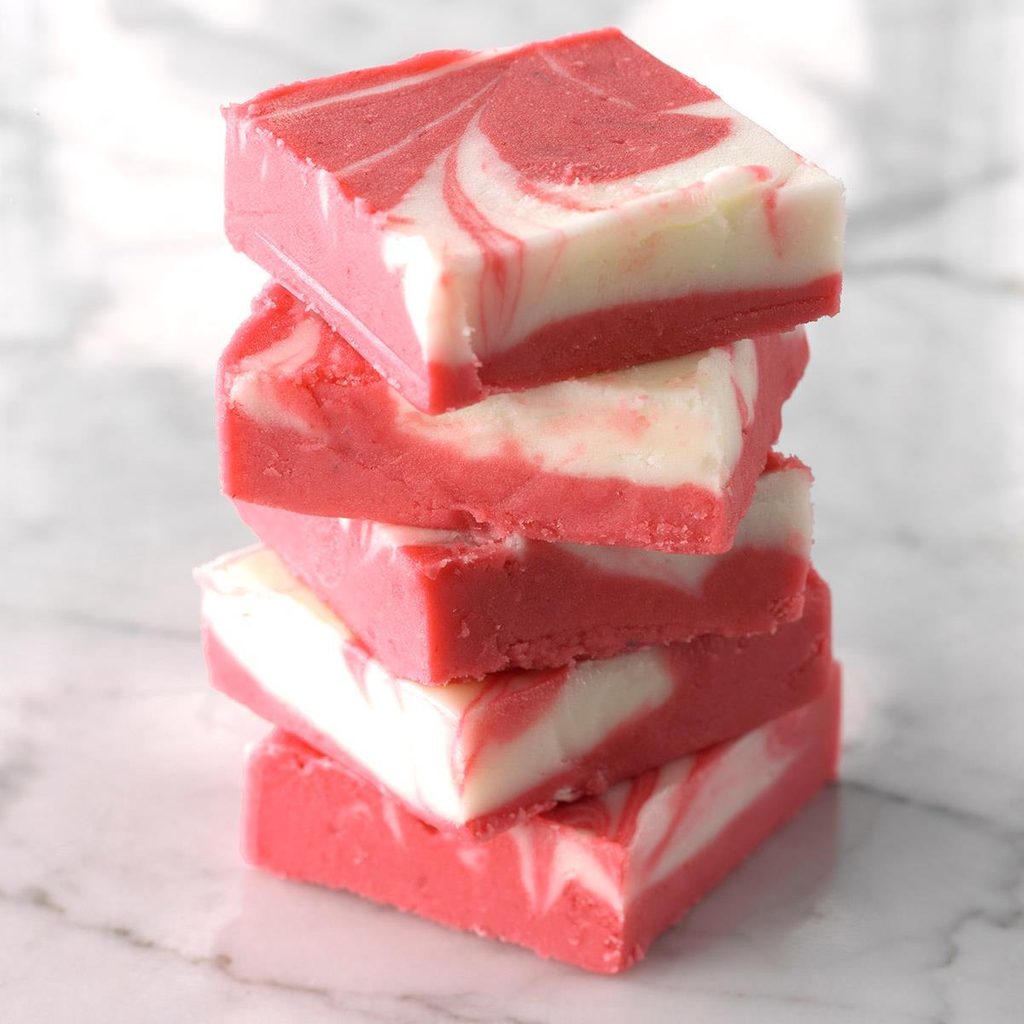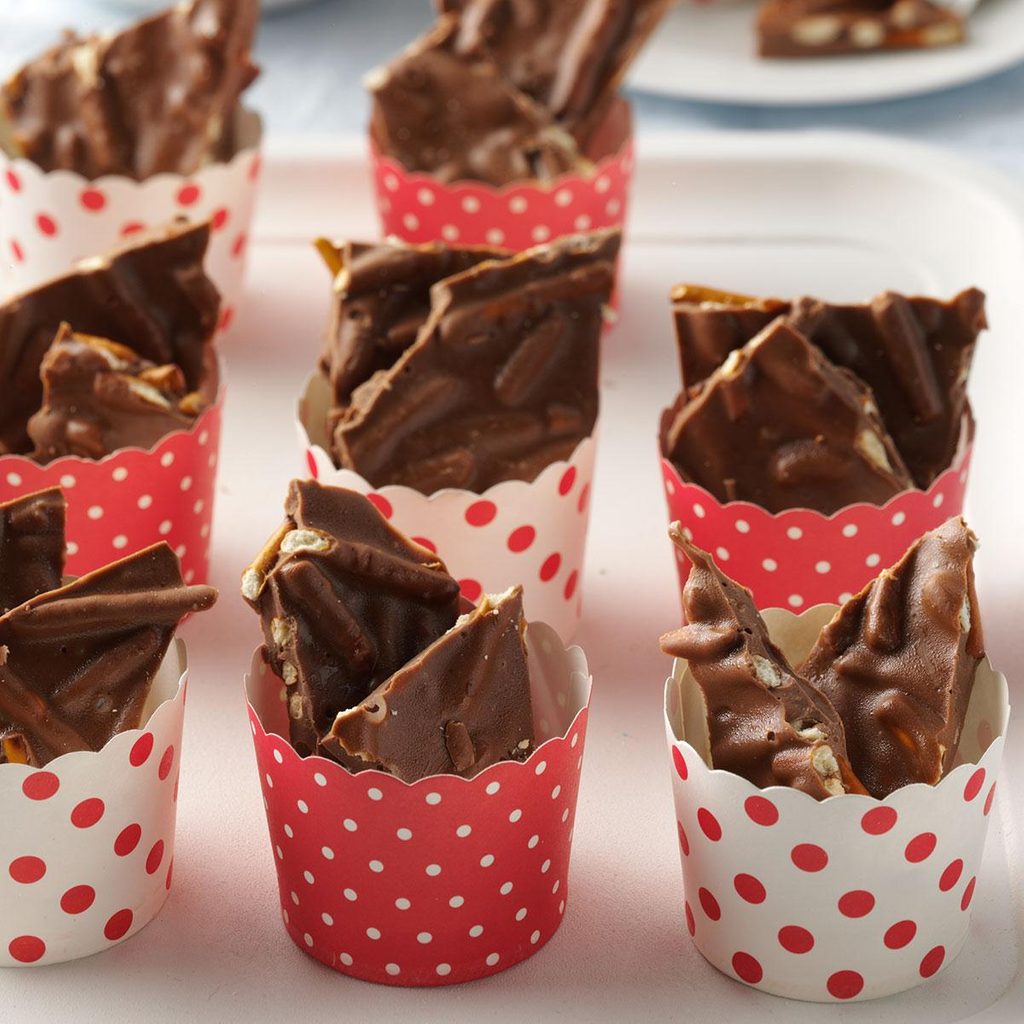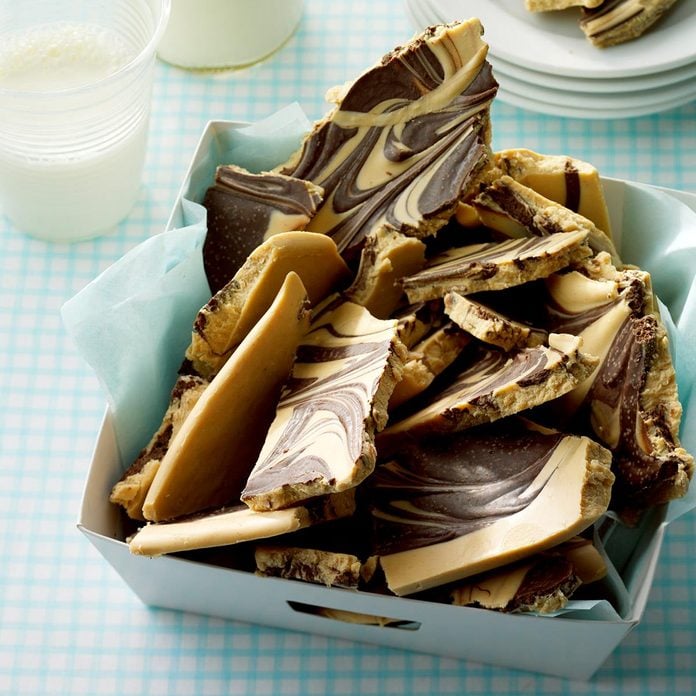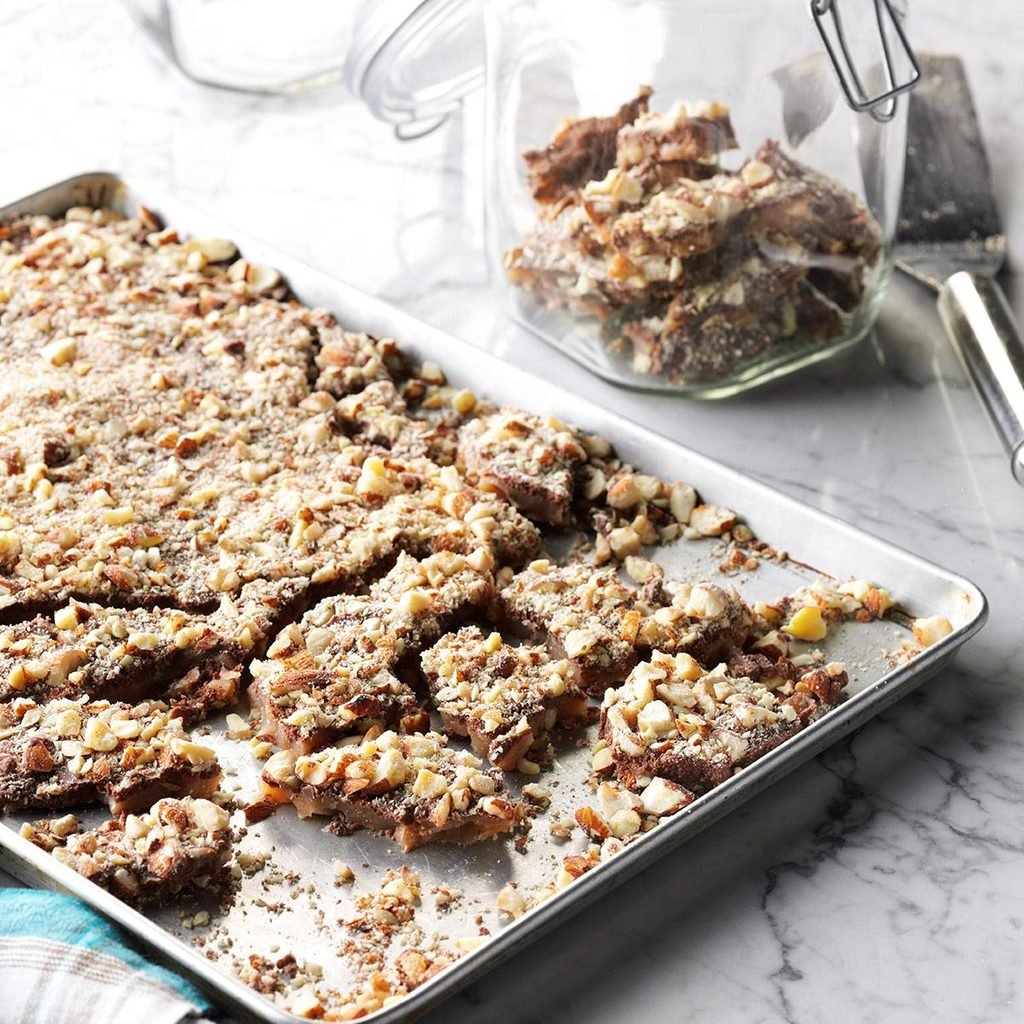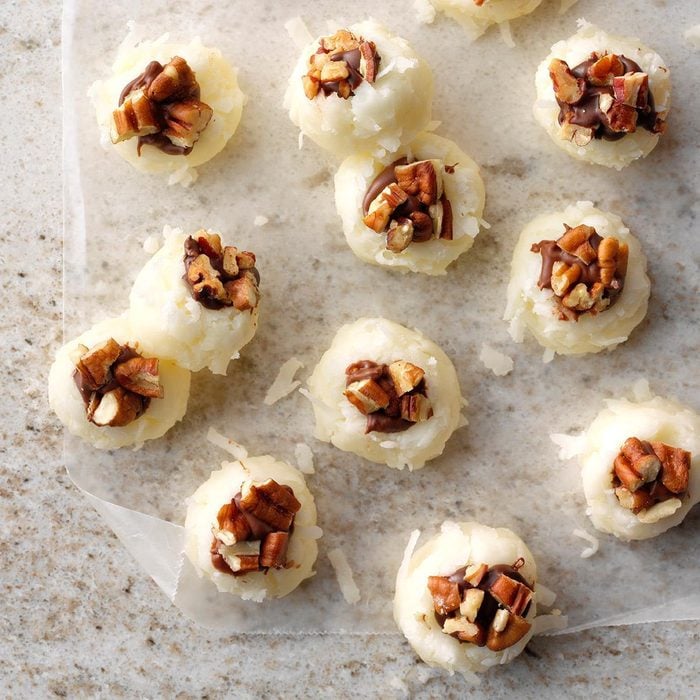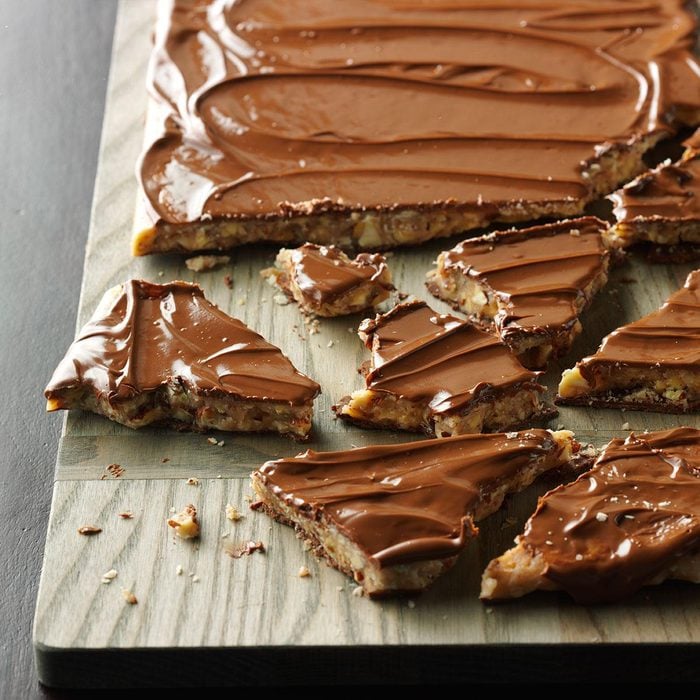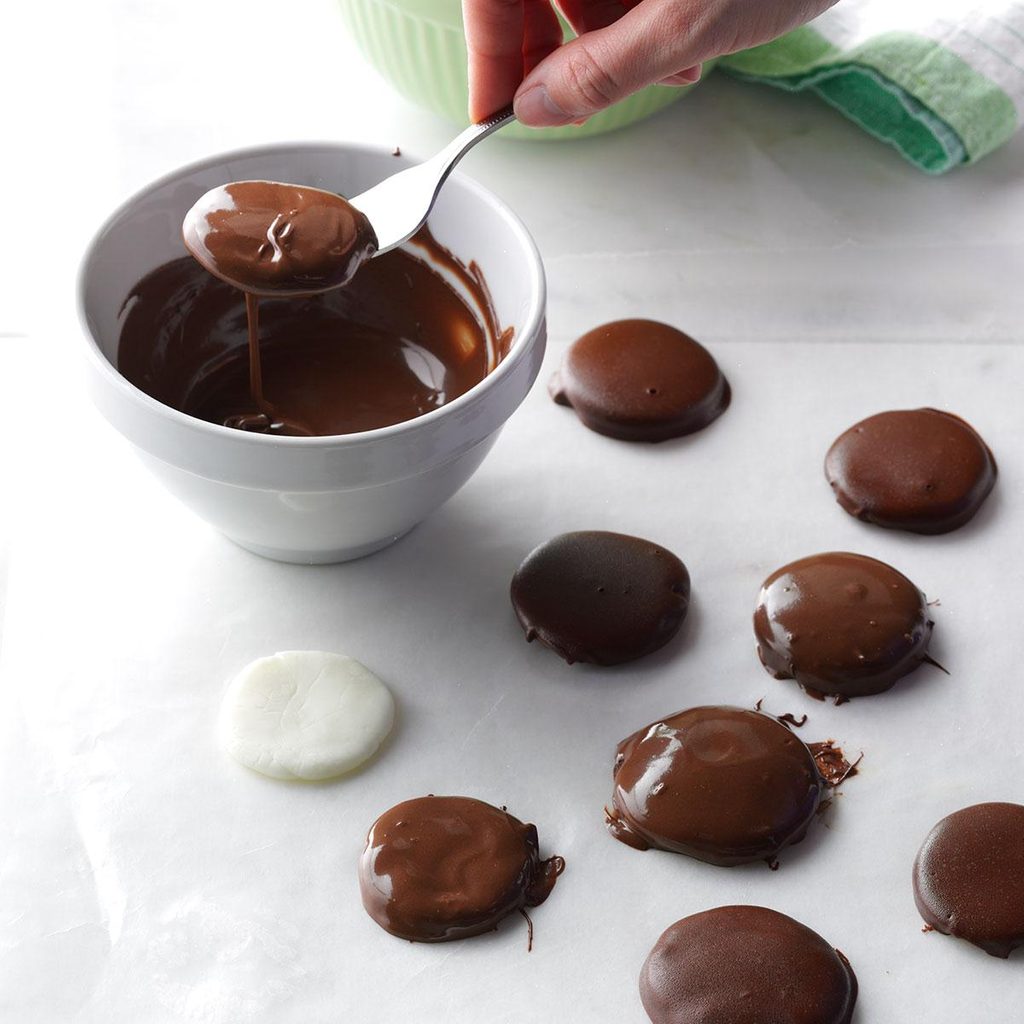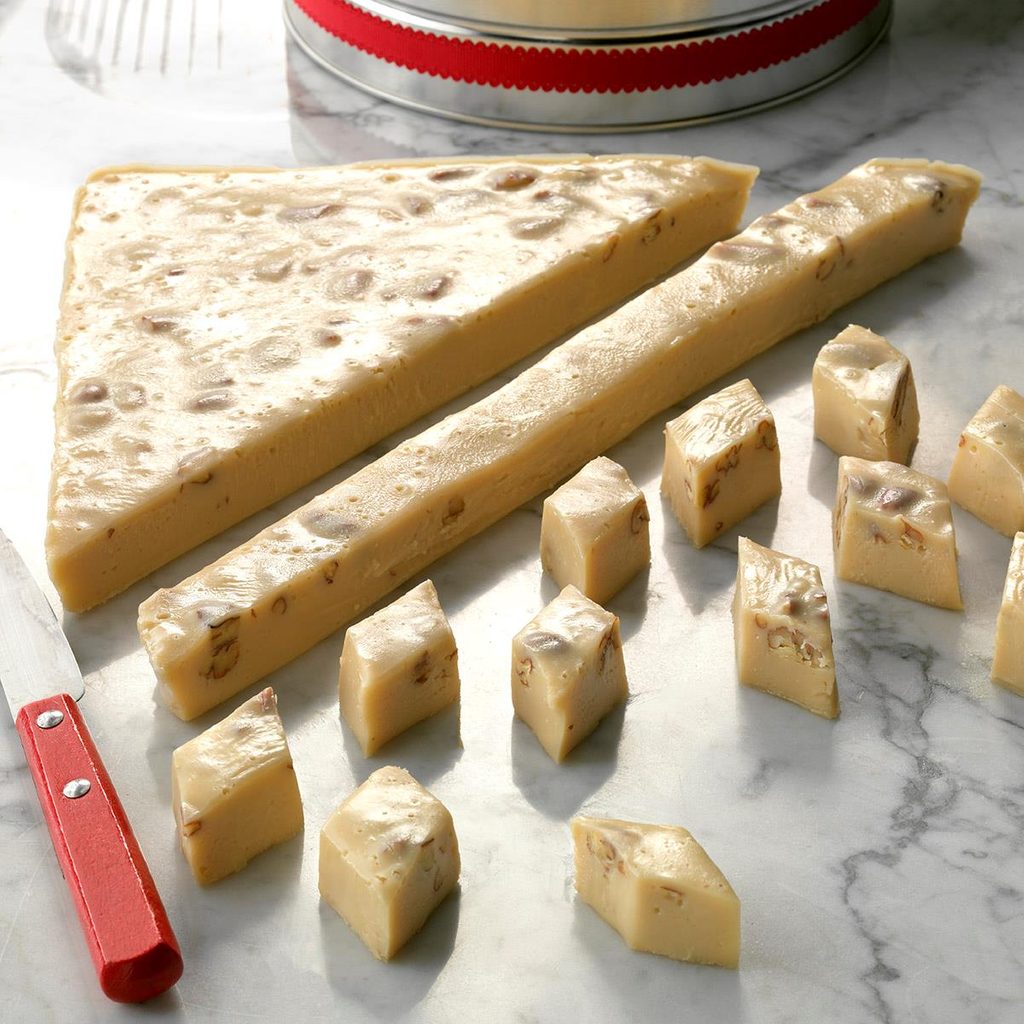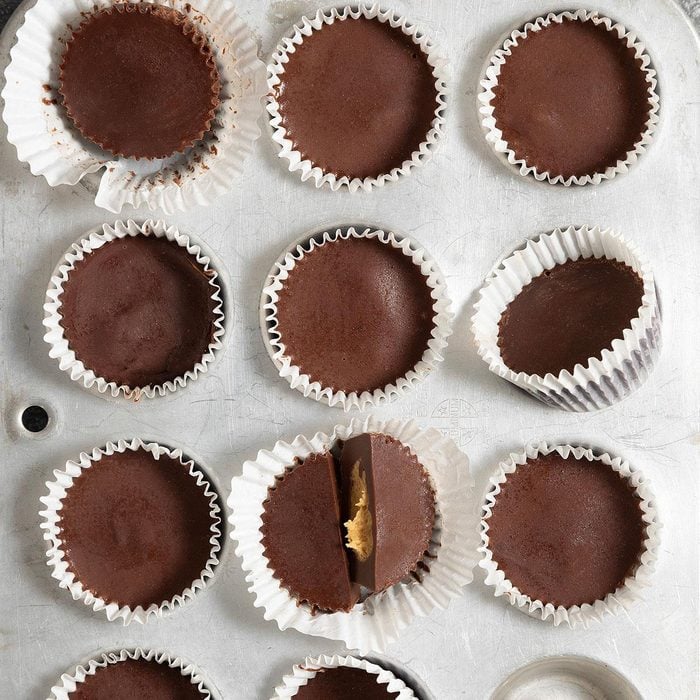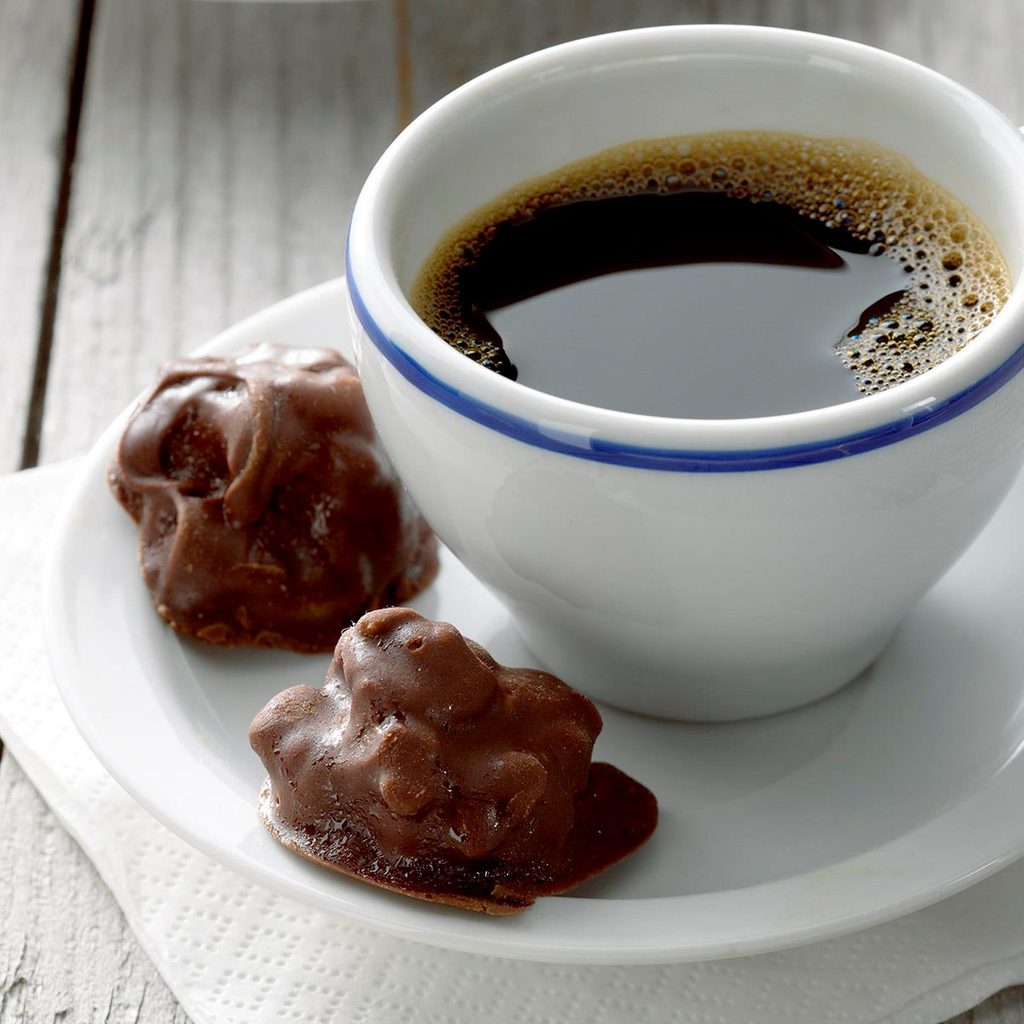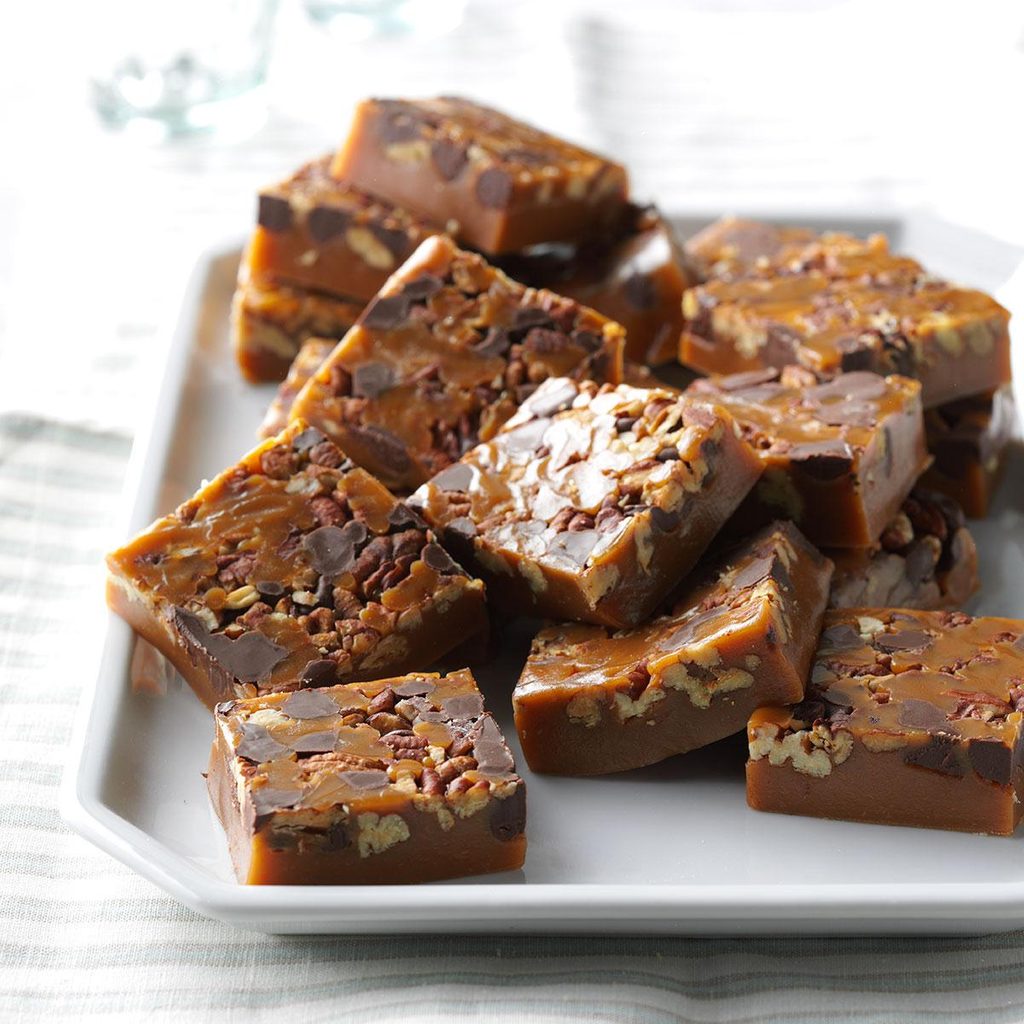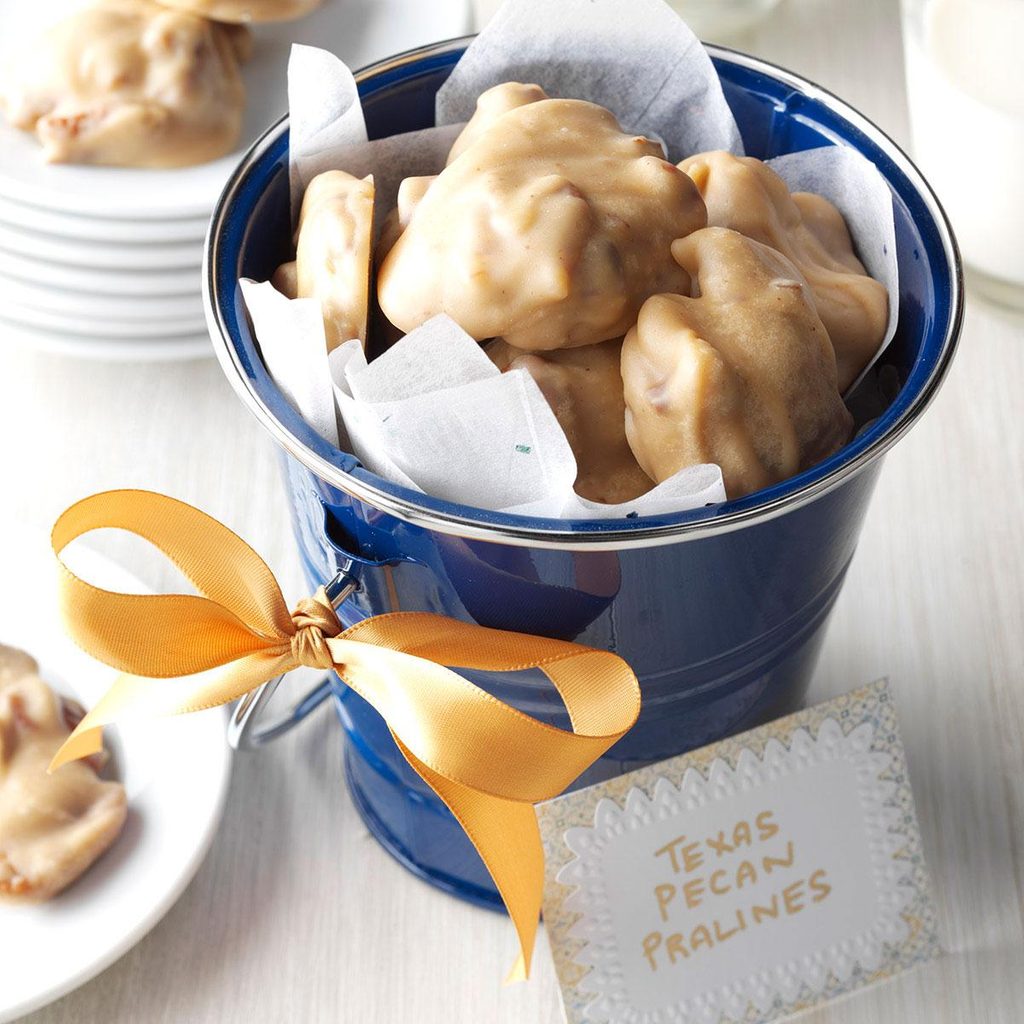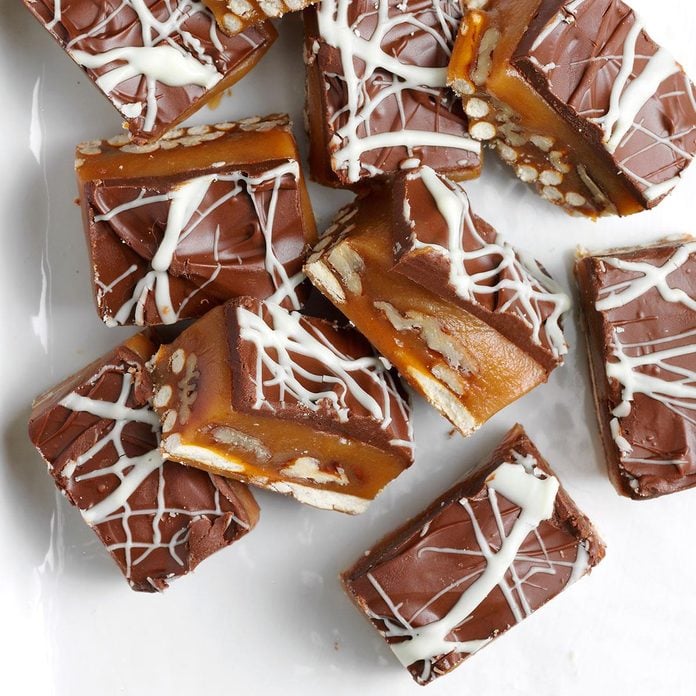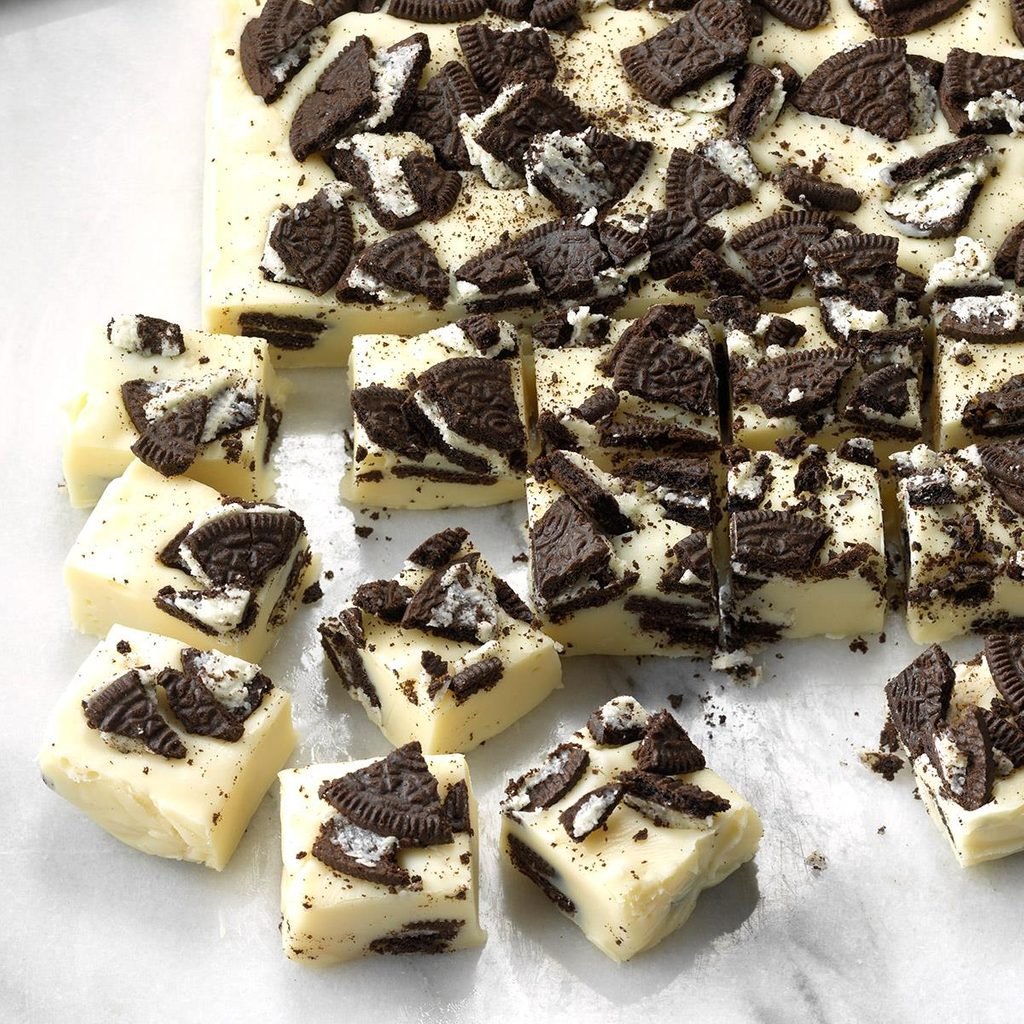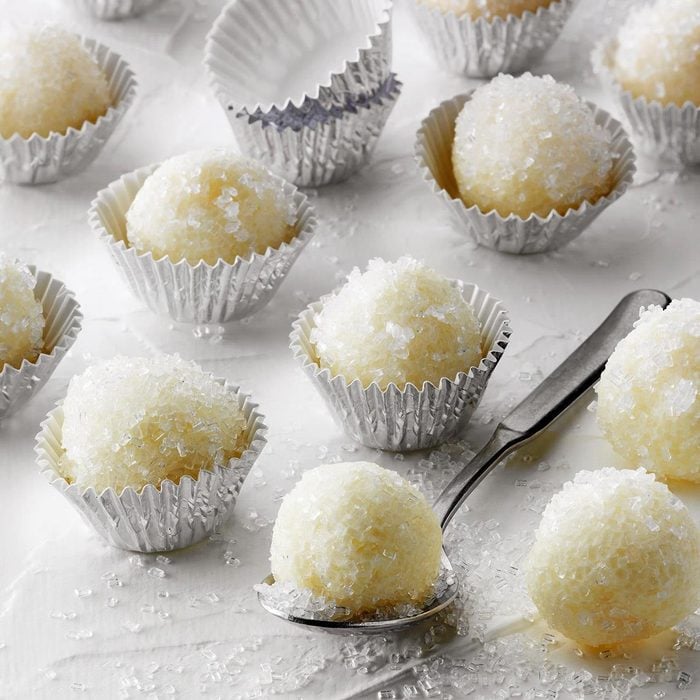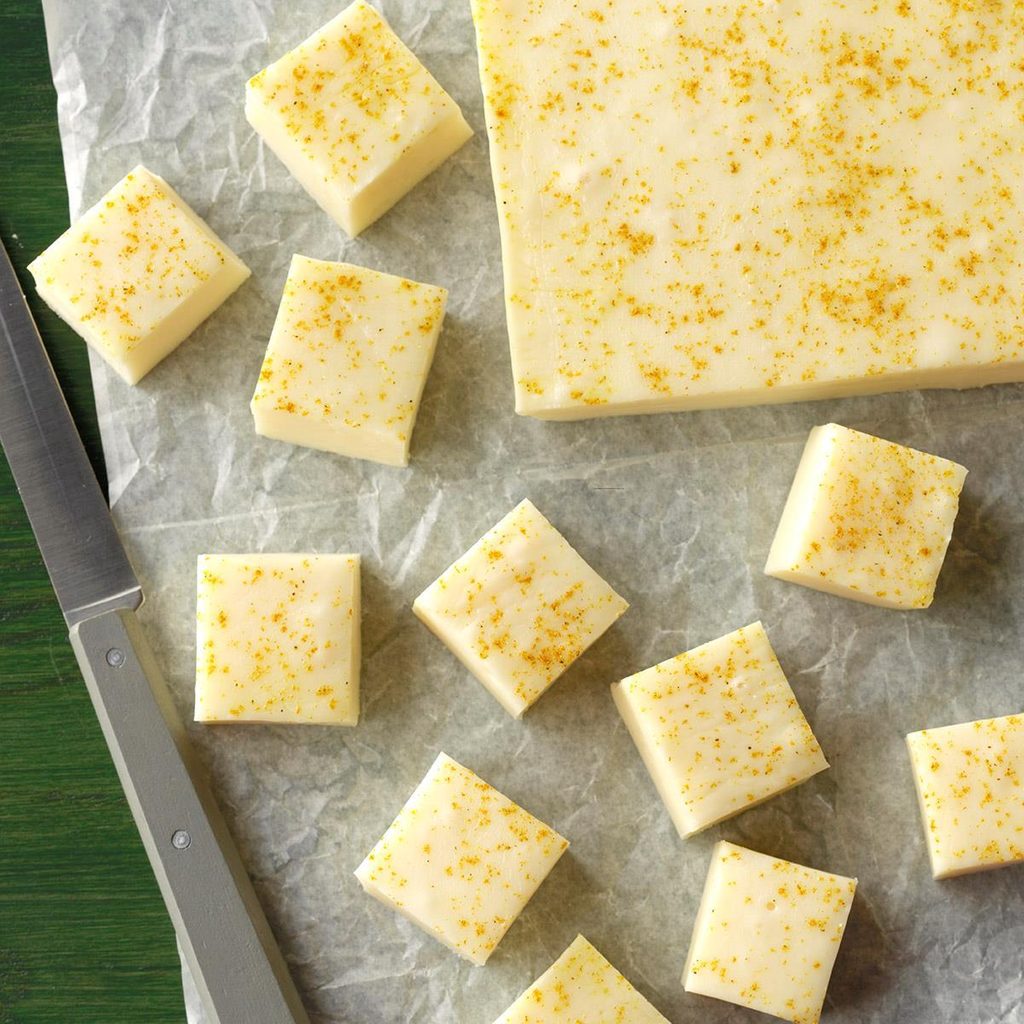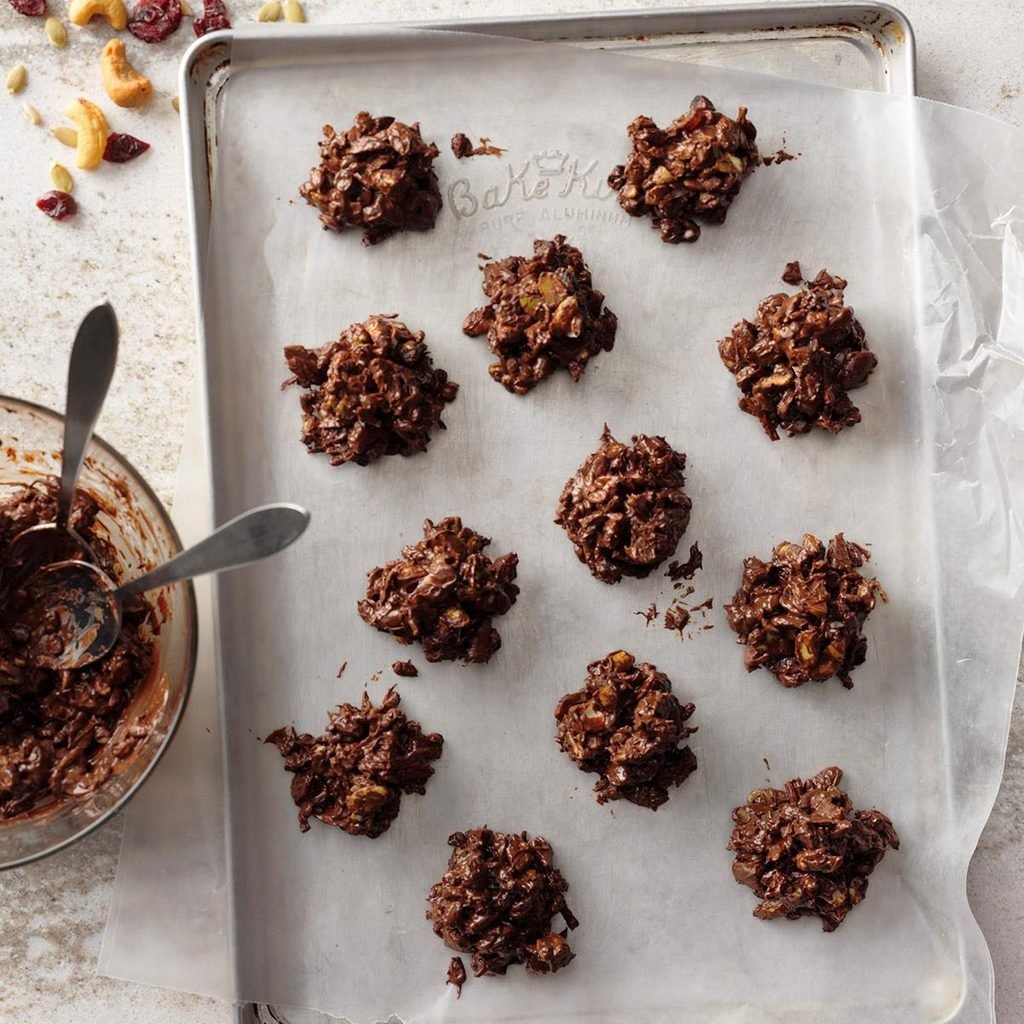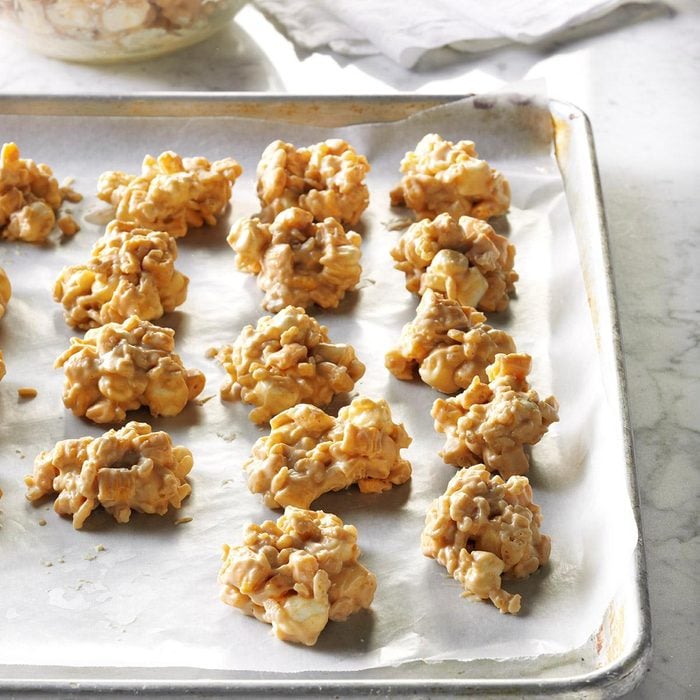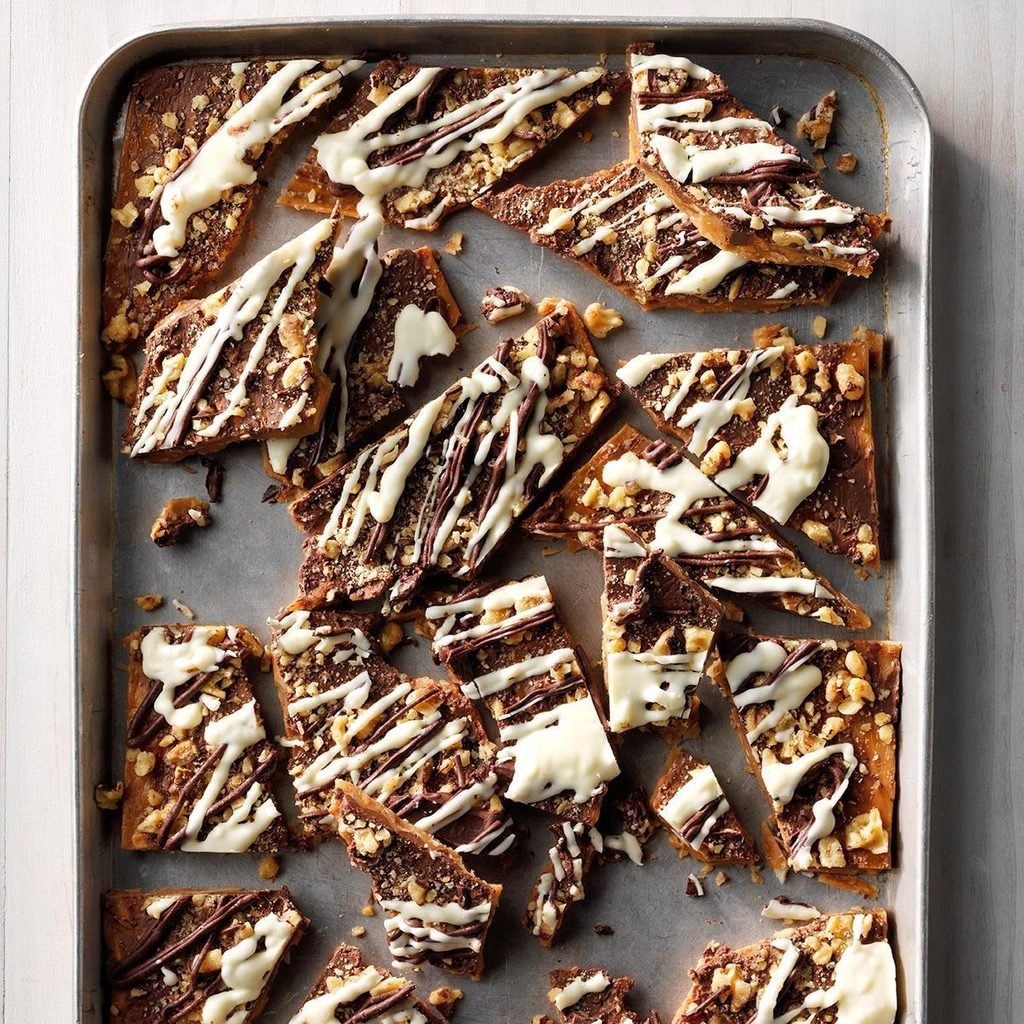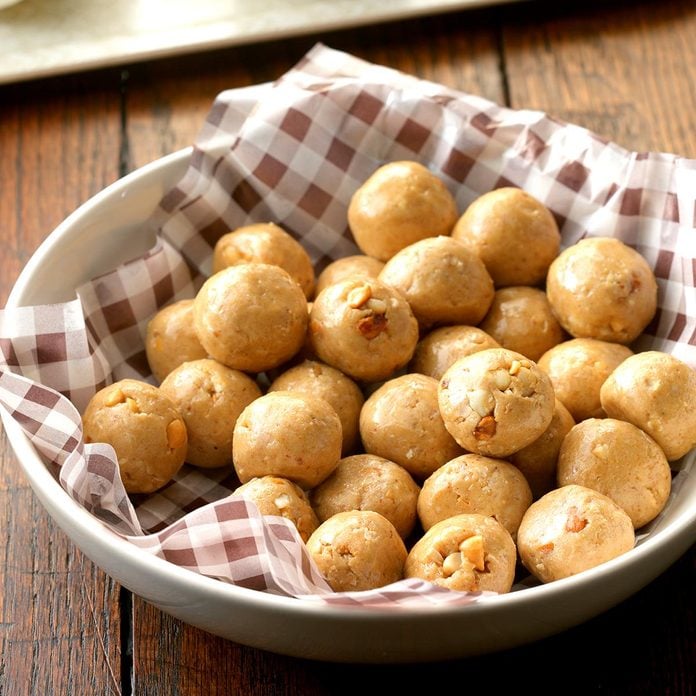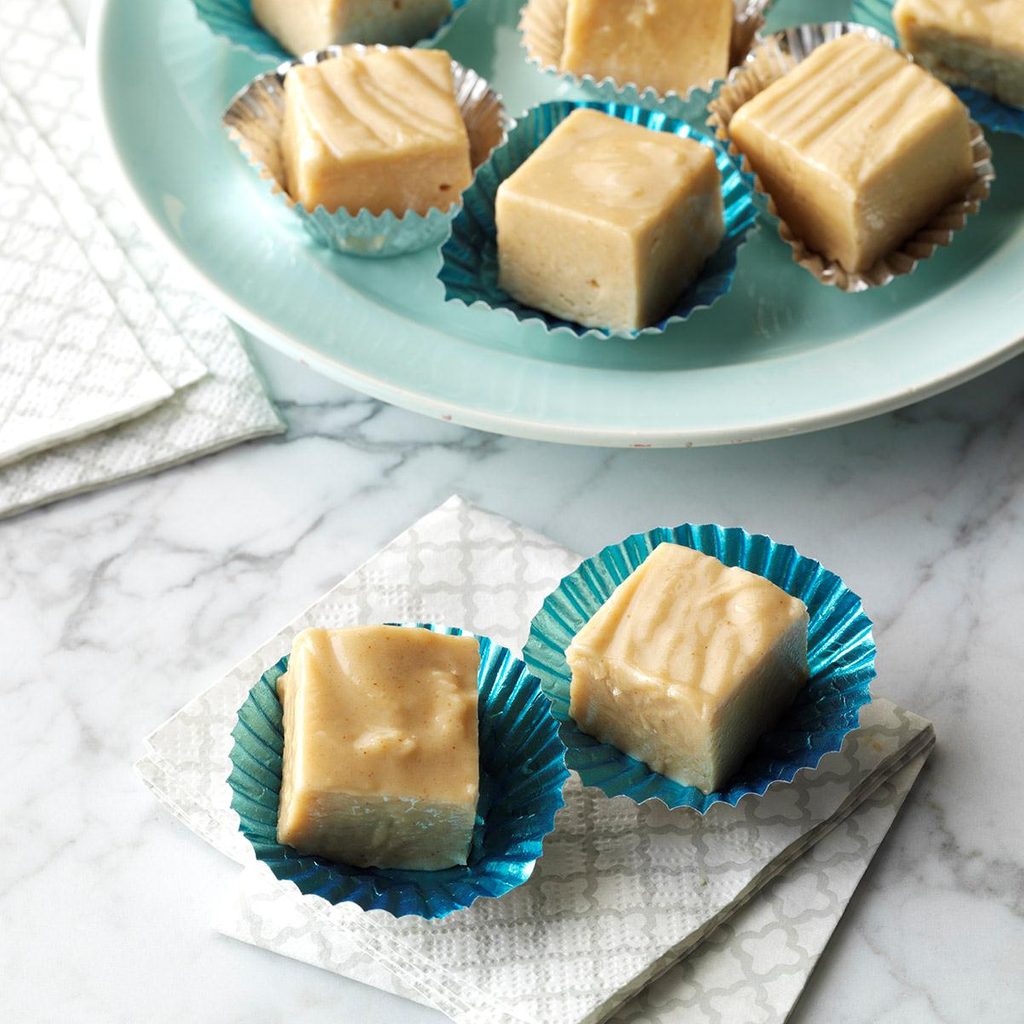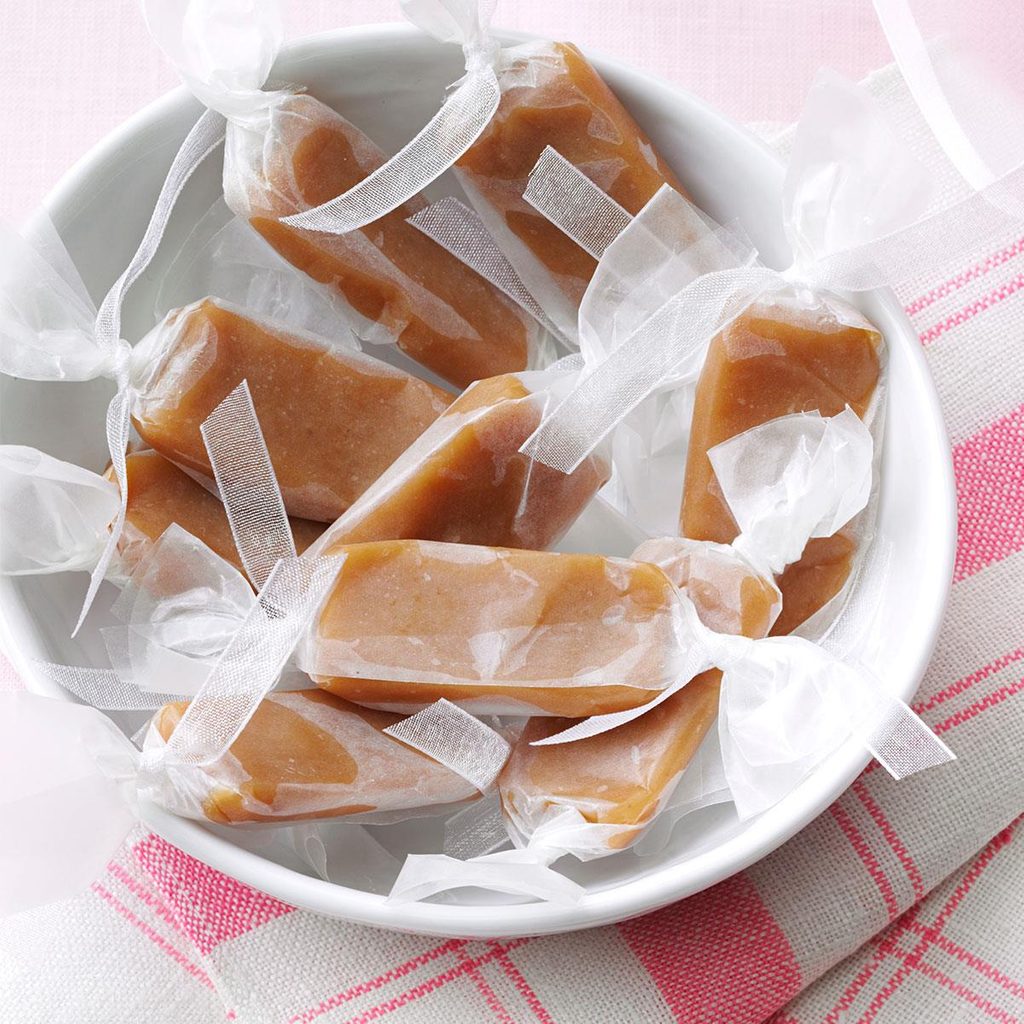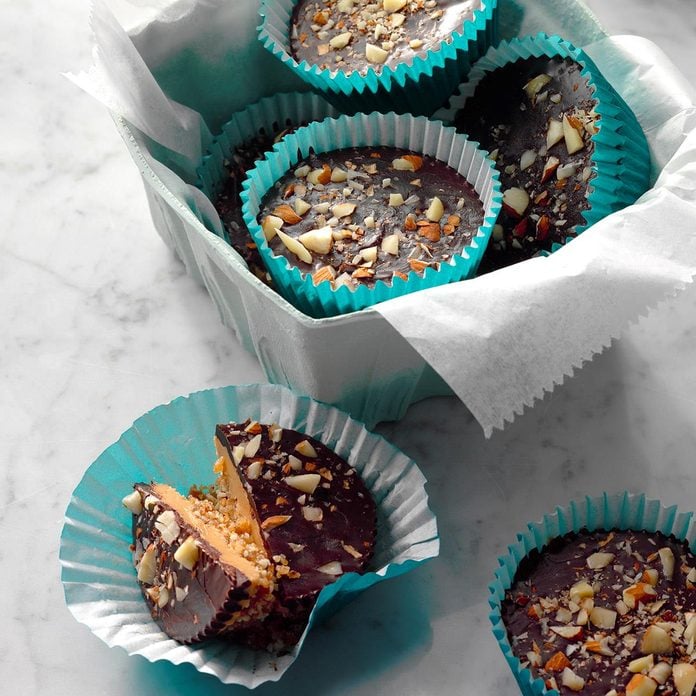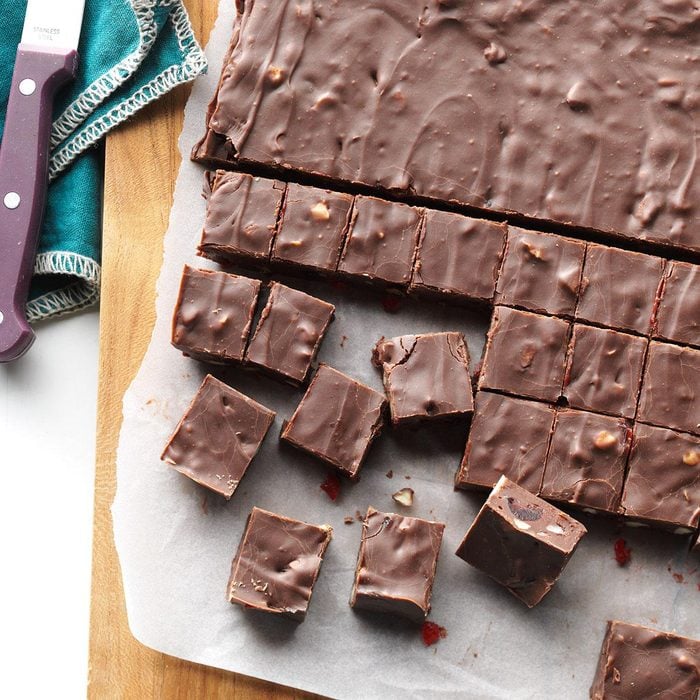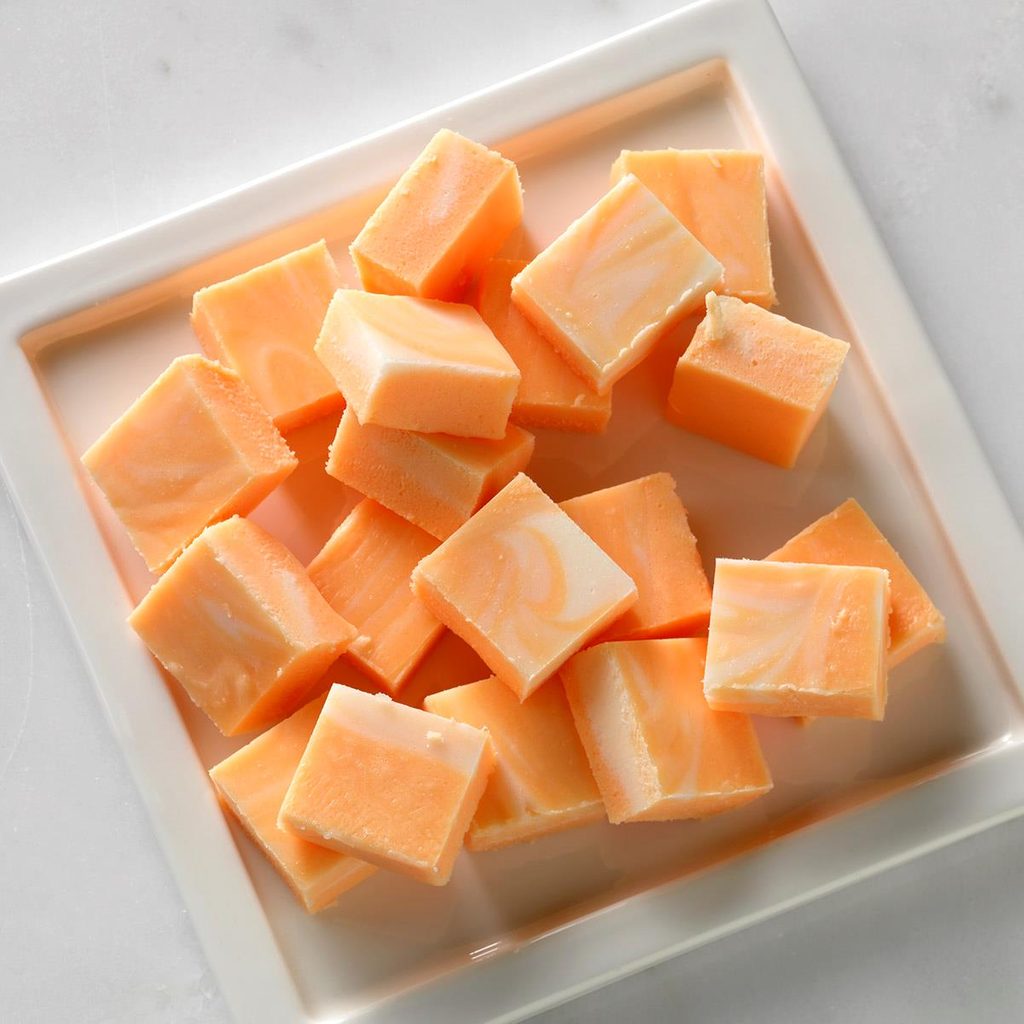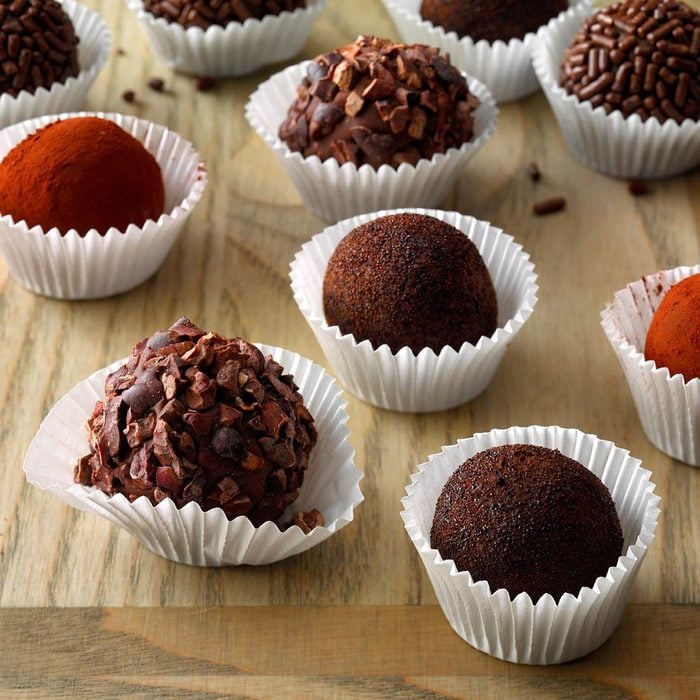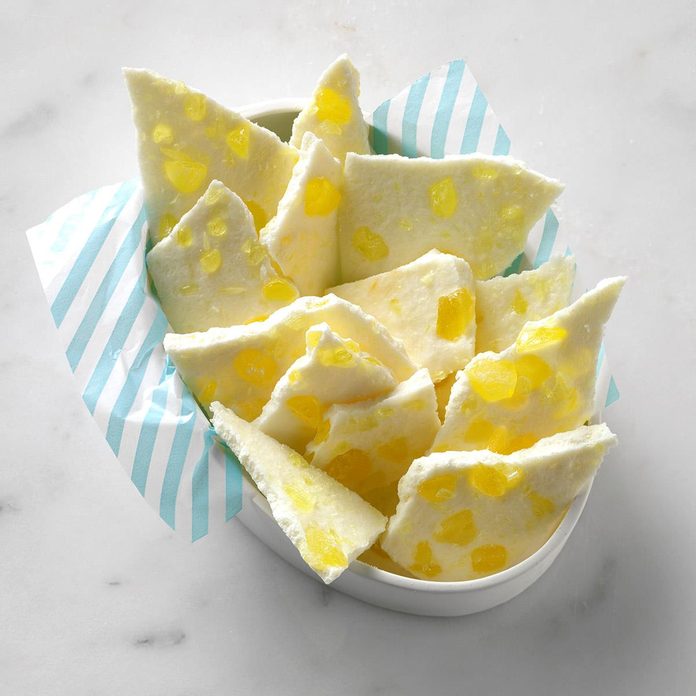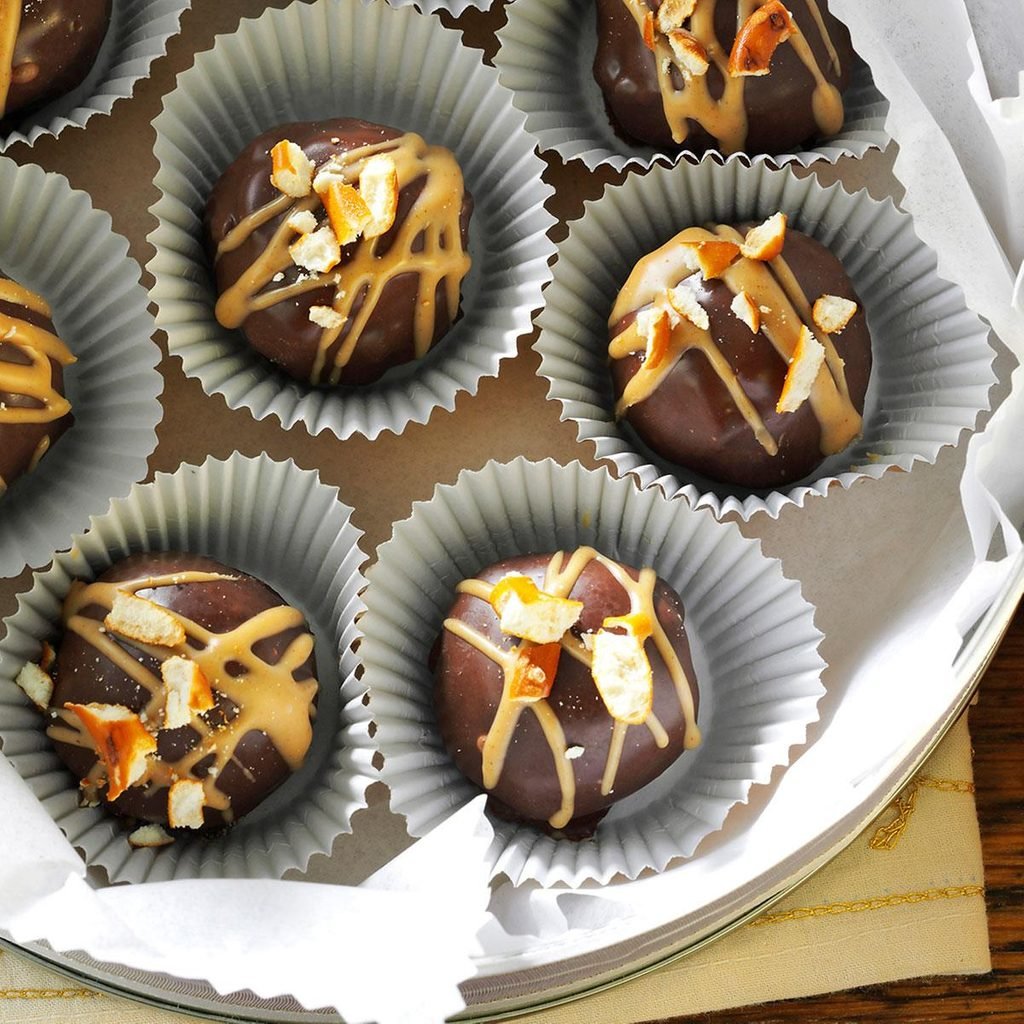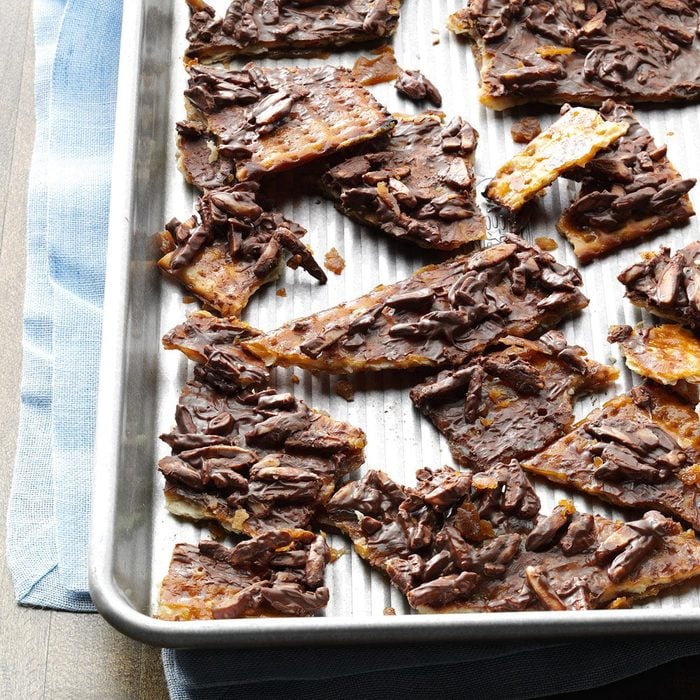Whether you’re making your own chocolate truffles for the holidays, cooking up a batch of fudge to give as a gift or making homemade candy as a fun everyday cooking project, this expert guide will show you how to make candy in your own kitchen.
How to Make Candy
Generally speaking, you make candy by heating sugar or melting chocolate and adding delicious flavors to make sweet, irresistible confections. The specific steps for how to make candy depend on the type of treat you’re creating and the recipe you choose to follow—there are dozens of homemade candy recipes to choose from!
Also, check this two ingredients fudge recipe, which is easy to make and will save a lot of your time.
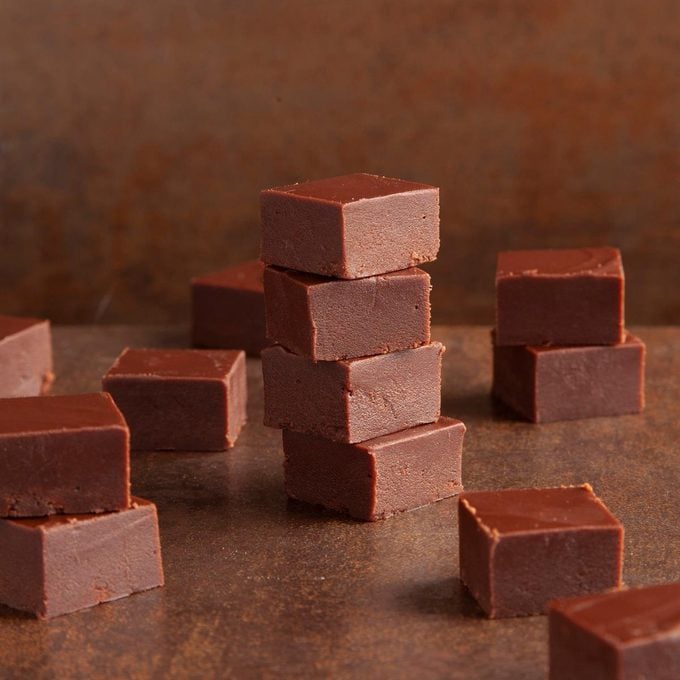 Taste of Home
Taste of Home
Fudge is a dense, chewy confection that’s made with milk, butter and sugar. Although it is often chocolate-flavored, there are fudge recipes for many other varieties, such as peanut butter, maple and butter pecan. Mackinac Fudge, which hails from an island in Michigan, is one of the most famous flavors. (Here’s the difference between fudge and ganache.)
There are two main ways to make fudge: in the microwave—here’s how to make microwave fudge—or on the stove, which is the traditional way. In either case, you heat milk, sugar and butter (or sweetened condensed milk and butter) to combine.
Depending on the type of fudge you’re making, you can add additional ingredients like cocoa powder or chocolate chips, or other flavors like white baking chips, peanut butter or peppermint extract. You can also add mix-ins like nuts, crushed cookies or sprinkles. Finally, you’ll let the fudge cool and set before slicing and serving.
Test Kitchen tip: Avoid common fudge mistakes like under- or overcooking the sugar, or overbeating the fudge batter. Once you’re done, here’s how to store fudge.
Go to Recipe
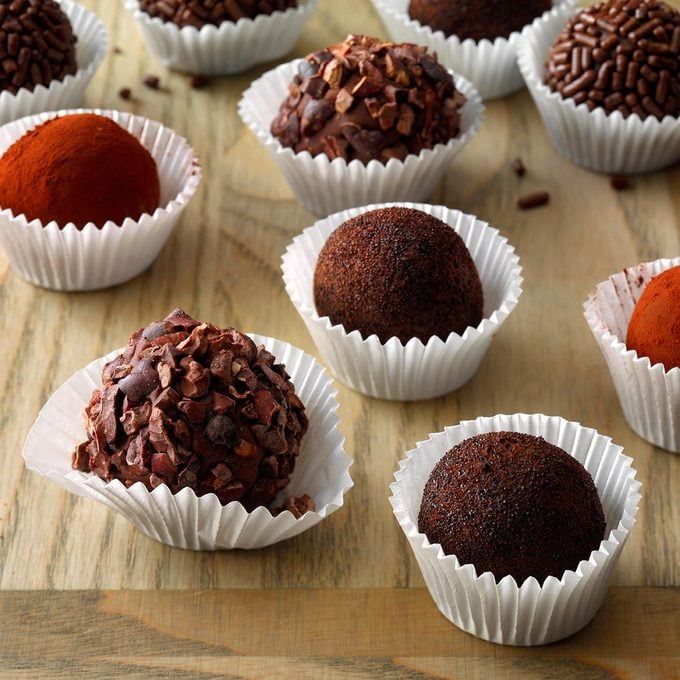 Taste of Home
Taste of Home
Chocolate truffles are traditionally filled with chocolate ganache, but you’ll see many chocolate- or candy-coated balls called “truffles”—including these Cookie Dough Truffles.
To make traditional chocolate truffles, heat chocolate and cream together, let the mixture set, roll it into balls and then cover it with toppings. Some chocolate truffle recipes call for sweetened condensed milk instead of cream.
When it comes to decorating chocolate truffles, get creative! Try coating your confections in cocoa powder, crushed cookies or sprinkles, or drizzling them with stripes of melted chocolate.
Test Kitchen tip: Avoid making common chocolate truffle mistakes like overheating the cream or using the wrong type of chocolate. Once you’re done, here’s how to store chocolate truffles.
Go to Recipe
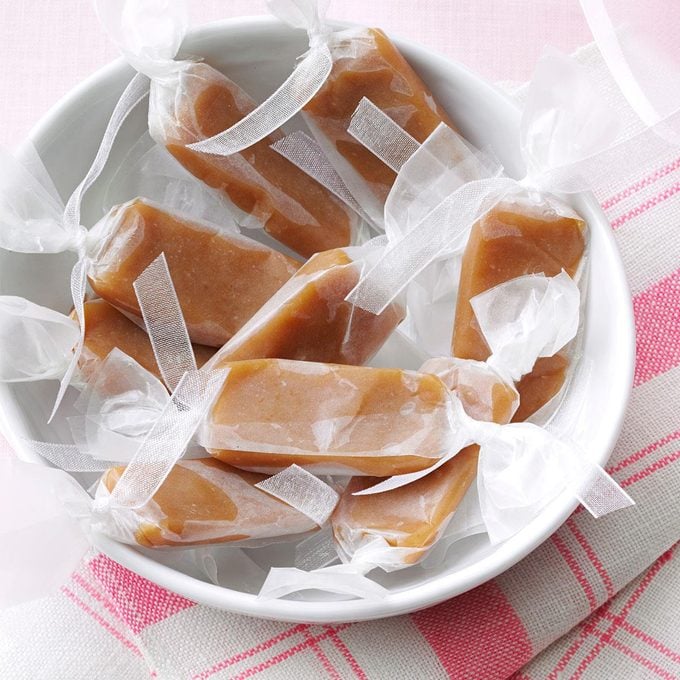 TMB Studio
TMB Studio
Caramel is a type of candy that’s made by cooking white granulated sugar and then adding dairy. There’s so much you can do with this sweet confection: Enjoy classic squares of caramel candy on their own, or use caramel sauce as an ingredient or topping for other desserts, like these salted caramel recipes.
Whether you’re whipping up one of our caramel candy recipes or a caramel sauce, like for these homemade caramel apples, making caramel involves cooking sugar (often with water) until it starts to brown or caramelize. Then you add dairy (butter, milk or cream), as well as salt and vanilla to get a creamy consistency and balanced flavor.
Test Kitchen tip: In order to get the right type of caramel for your recipe, it’s important to understand the different stages of caramel, from light to very dark. You’ll also want to avoid these common caramel-making mistakes. Once you’re finished, here’s how to store caramel.
Go to Recipe
Other Types of Candy
While fudge, chocolate truffles and caramel are some of the most popular types of homemade confections, candy comes in all shapes and sizes. Some candy recipes are hard to categorize, like these easy Cream Cheese Candies, but many of the most popular homemade candies fall into the following categories. Beyond these, some candy is seasonal—for inspiration, check out our Christmas candy recipes and Halloween candy recipes.
Also, make your holidays extra merry with these Christmas candy recipes.
Butterscotch
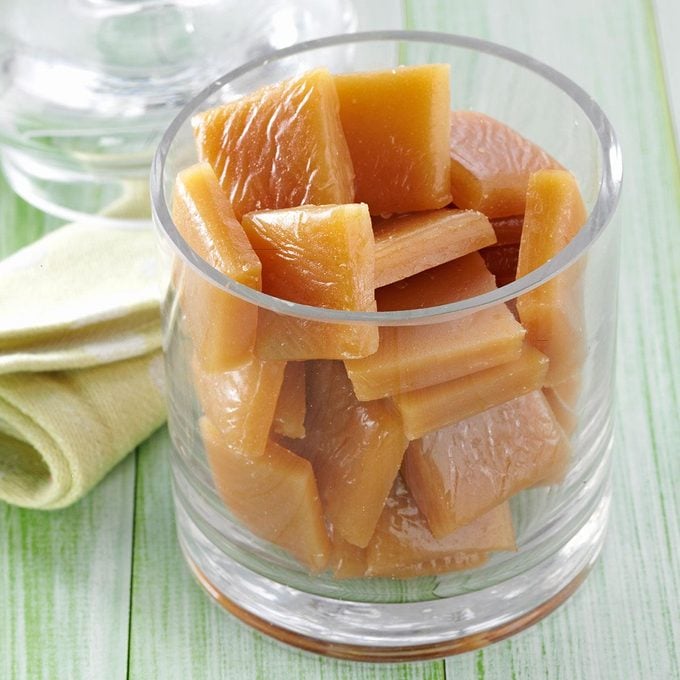 Taste of Home
Taste of Home
Butterscotch is similar to caramel but it’s generally made with brown sugar instead of white sugar—though there are variations, like this Butterscotch Hard Candy recipe with sugar, rum extract and corn syrup. Similar to caramel, butterscotch can be a candy as well as an ingredient in other desserts, like in these old-fashioned butterscotch recipes.
Here’s more on the difference between caramel, butterscotch and toffee.
Chocolates
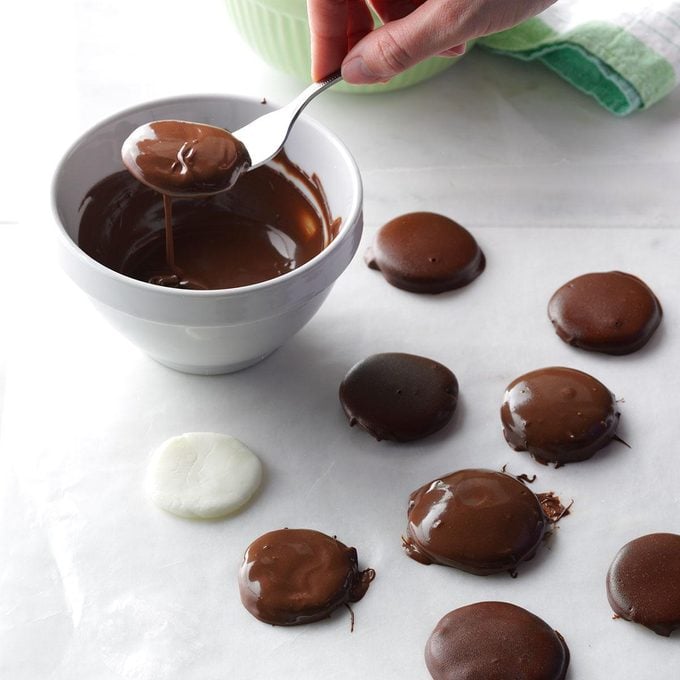 TMB Studio
TMB Studio
There are many different types of chocolate candies, including:
Gummy Candy
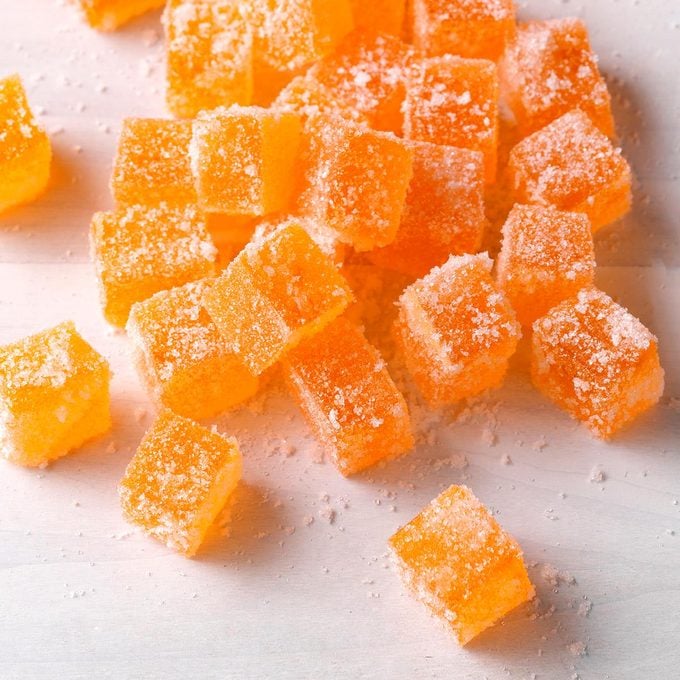 Taste of Home
Taste of Home
If you’re not a fan of chocolate but still have a sweet tooth, you might enjoy making gummy candy, like these Orange Gumdrops. Start with a Quick & Easy Gumdrops recipe or branch out and try Mulled Wine Jelly Candies.
Hard Candy
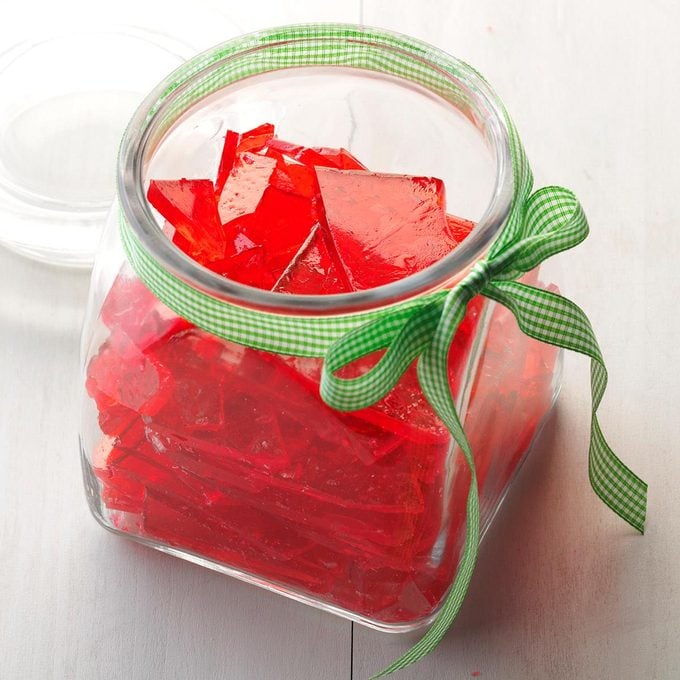 Taste of Home
Taste of Home
From rock candy and lollipops to cinnamon and peppermint hard candies, old-fashioned treats elicit childhood nostalgia. For the most part, the ingredients are simple: sugar, water, flavoring and food coloring!
Toffee
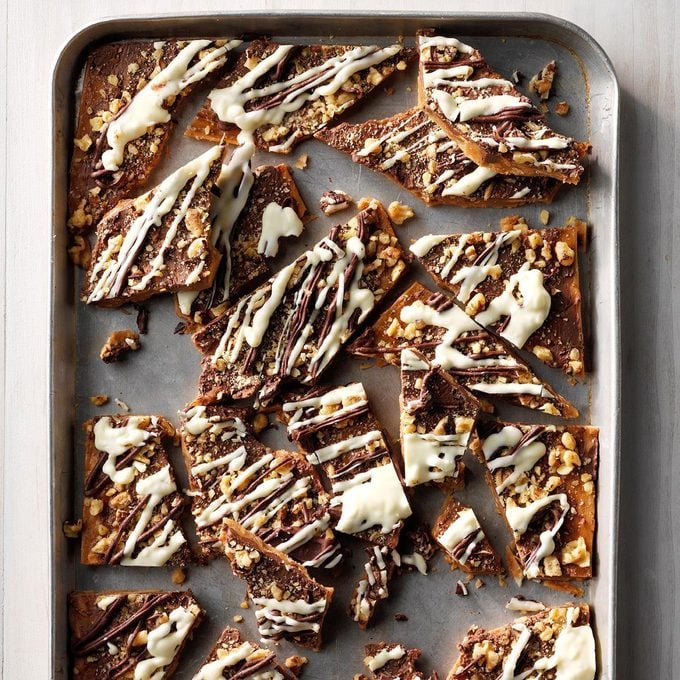 Taste of Home
Taste of Home
Like caramel, toffee is made by heating sugar until it browns. But to make toffee, you cook the sugar and butter for a longer amount of time until it reaches a harder consistency. We love classic butter toffee, this Three-Chip English Toffee and toffee bark made with saltine crackers. But if you’re short on time, and want to enjoy a sweet delight, you have to try these British candies.
Candy-Making Supplies
The candy-making tools and ingredients you’ll need will depend on the type of candy you’re making and the method you’re using. Here are a few supplies that may come in handy.
Tools for Homemade Candy
- If you’re making candy in the microwave, use a microwave-safe glass bowl. It also helps to have a candy thermometer. If you don’t have one, you can use a method called the cold-water test (explained below) to gauge your candy’s doneness.
- When making candy on the stove, you’ll want a heavy saucepan that’s deep enough for the sugar mixture to bubble without nearing the top of the pan.
- Candy molds in different shapes, like flowers or stars, take your homemade candy to the next level.
Ingredients for Homemade Candy
When it comes to making candy, you need to know the differences between types of chocolate and related products.
- Baking chocolate: While there are many different types of baking chocolate, it’s typically sold in bars and is designed to melt quickly and smoothly.
- Chocolate chips: Chocolate chips are great for baking but they’re not always the best for homemade candy. If your candy recipe does call for them, here are the best chocolate chips to buy, according to our Test Kitchen.
- Candy coating: Also known as almond bark or confectionery coating, this usually comes in 1-1/2 to 2-pound blocks or in bags of small, flat disks. When dipping candy in chocolate, it’s best to use candy coating because it becomes firm at room temperature.
Test Kitchen tip: You can also use melted chocolate chips as a candy coating—simply stir in 1 tablespoon of shortening for every 6 ounces of chips.
Homemade Candy Tips
Between understanding the different sugar stages and learning how to properly temper chocolate, there are many techniques to master when you’re making your own candy.
Test Kitchen tip: When you’re making candy at home, choose a day when the humidity is less than 60 percent. High humidity can affect the texture of confections like soft caramels, peanut brittle and hard candy.
How to Use a Candy Thermometer
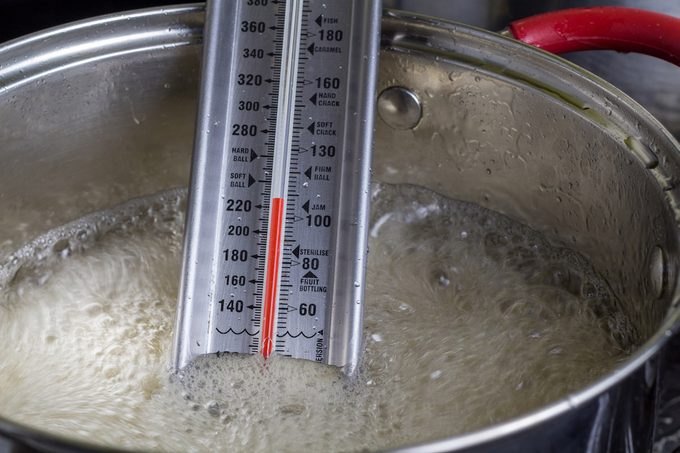 ToscaWhi/Getty Images
ToscaWhi/Getty Images
Many candy recipes require a candy thermometer to help gauge the consistency of the sugar syrup. There are candy thermometers that attach to the side of your saucepan, as well as candy thermometers with a probe that you insert into your candy mixture.
For best results, test your thermometer’s accuracy before each use. To do so, place it in a saucepan of boiling water; it should read 212°F. If it doesn’t, adjust your recipe temperature based on the results of the test.
When using your candy thermometer, attach it to the side of the saucepan if possible but don’t let the bulb touch the bottom of the pan. Read the thermometer at eye level. To avoid breaking it, let the thermometer cool before washing it.
How to Use the Cold-Water Test
If you don’t have a candy thermometer, you can use the cold-water test to determine the syrup concentration in your candy. First, fill a small glass bowl with cold water. Dip a metal spoon into the hot candy mixture and drop a small amount into the cold water. Let the candy cool, then remove it from the water. The candy will have a different consistency depending on its sugar stage.
Thread Stage
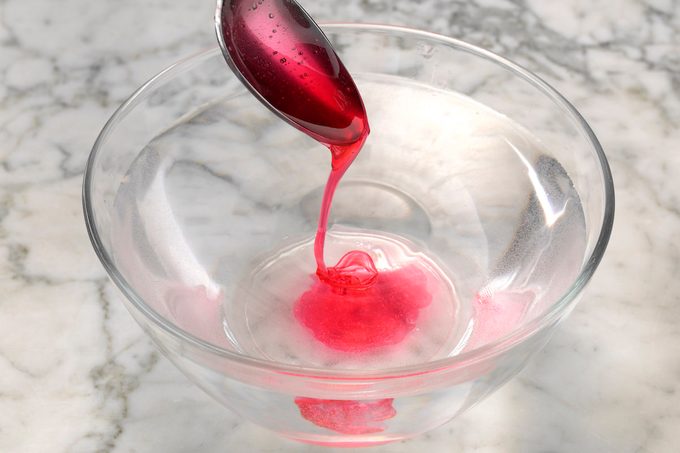 Taste of Home
Taste of Home
In thread stage, candy will measure 230° to 233° on a thermometer. Using the cold-water test, the mixture will fall off the spoon in a fine thread.
Soft-Ball Stage
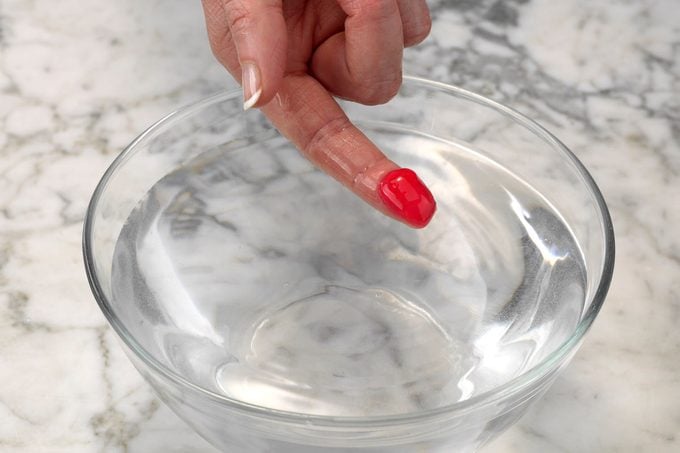 Taste of Home
Taste of Home
In soft-ball stage, candy will measure 234° to 240° on a thermometer. It will form a ball in cold water and then flatten on your finger after being removed from the water.
Firm-Ball Stage
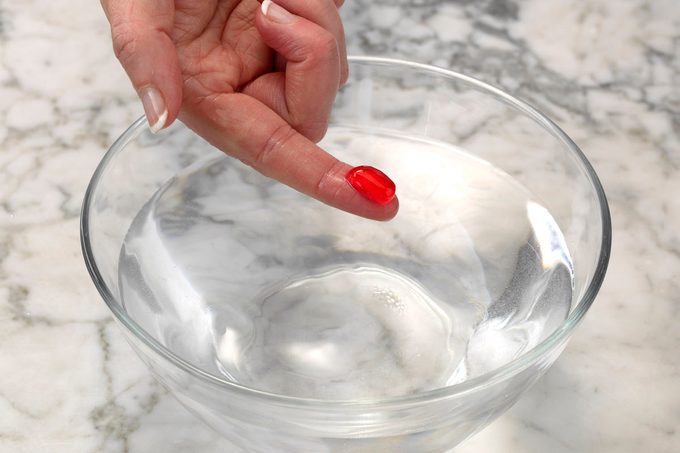 Taste of Home
Taste of Home
In firm-ball stage, candy will measure 244° to 248° on a thermometer. It will form a ball in cold water and hold its shape when you remove it from the water.
Hard-Ball Stage
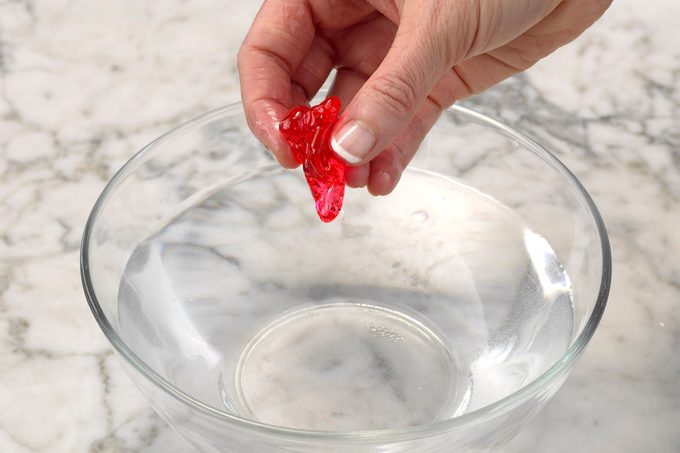 Taste of Home
Taste of Home
In hard-ball stage, candy will measure 250° to 266° on a thermometer. It will form a ball in cold water and maintain a hard yet pliable ball when you remove it from the water.
Soft-Crack Stage
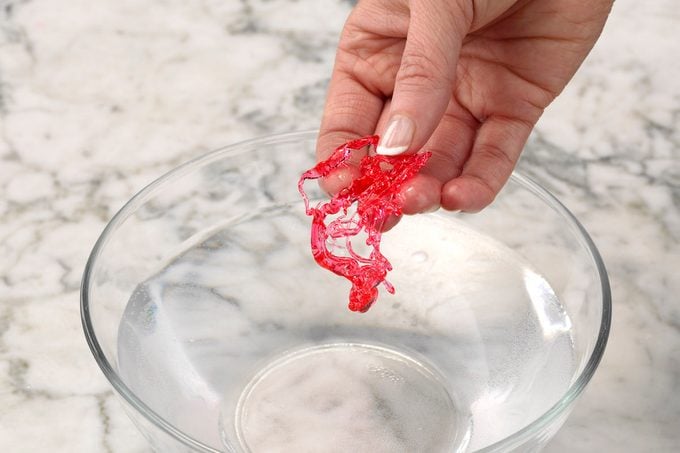 Taste of Home
Taste of Home
In soft-crack stage, candy will measure 270° to 290° on a thermometer. The candy will form threads when it touches cold water. When you remove it from the water, it will bend easily and pull apart cleanly.
Hard-Crack Stage
 Taste of Home
Taste of Home
In hard-crack stage, candy will measure 300° to 310° on a thermometer. The candy will form threads when it touches cold water and feel hard and brittle when you remove it from the water.
Chart: Candy Sugar Stages
Depending on the type of candy you’re making, you’ll want to cook the sugar until it reaches a certain consistency. Whether you use a candy thermometer or the cold-water test, it’s important to understand when it’s time to stop cooking your candy—and how to tell if you’ve gone too far.
| Sugar Stage |
Temperature |
Cold Water Test |
Use |
| Thread Stage |
230° to 233° |
The hot candy mixture will fall off a spoon and form fine threads in the water. |
Syrup |
| Soft-Ball Stage |
234° to 240° |
The candy mixture will form a ball in the water and then flatten on your finger when you remove it. |
Fudge |
| Firm-Ball Stage |
244° to 248° |
The candy will form a ball in cold water and hold its shape after you remove it from the water. |
Caramels |
| Hard-Ball Stage |
250° to 266° |
The candy will form a ball in cold water and remain a hard-yet-pliable ball after you remove it from the water. |
Divinity candy |
| Soft-Crack Stage |
270° to 290° |
The candy mixture will separate into threads when it touches the cold water. When you remove it from the water, it will bend easily and pull apart cleanly. |
Taffy |
| Hard-Crack Stage |
300° to 310° |
The candy mixture will separate into threads when it touches the cold water. When you remove it from the water, it will be hard and brittle. |
Brittles, lollipops |
How to Melt and Temper Chocolate
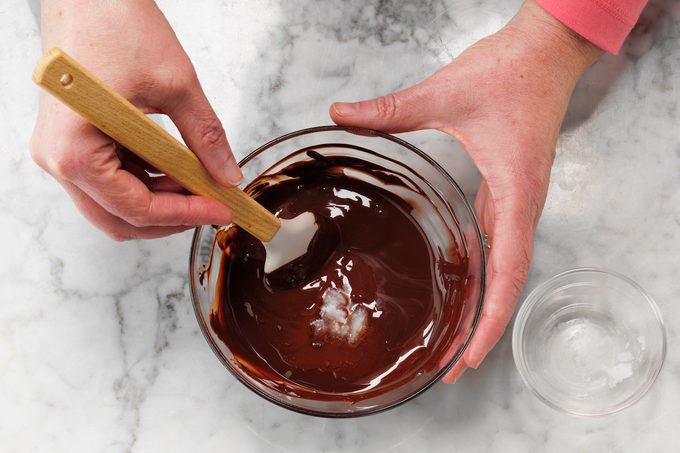 Taste of Home
Taste of Home
Many candy recipes require melted chocolate. There are many different ways to melt chocolate, including on the stovetop, in the microwave and in a slow cooker. Whichever method you choose, proceed carefully because chocolate scorches easily.
When you’re melting chocolate for making candy or other chocolate-dipped treats, it’s important to properly temper the chocolate in order to give it a smooth, hard finish. Tempering is a precise process of heating and cooling chocolate to specific temperatures in order to stabilize it—follow our detailed guide for how to temper chocolate.
Test Kitchen tip: Keep all moisture away from melted chocolate—even a small drop of water can make the chocolate seize (clump and harden). If this happens, stir in 1 tablespoon of vegetable oil for every 6 ounces of chocolate. However, if chocolate seizes due to excessive heat, you unfortunately can’t save it.
How to Package and Store Candy
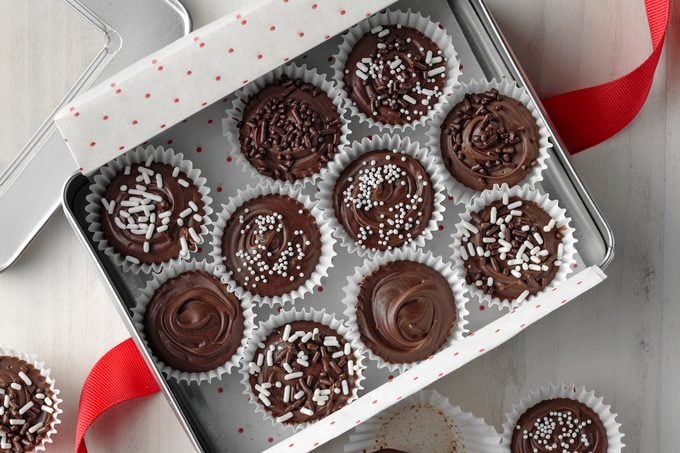 Taste of Home
Taste of Home
Whether you’re giving candy as a gift, serving it at a party or storing it to eat later, keep the following tips in mind.
How to Package Candy for a Gift
- For a professional look, place individual pieces of candy in miniature cupcake liners.
- Try packing the sweets in different kinds of containers such as miniature boxes, cookie tins, woven baskets and decorative jars.
- Decorate packages with handmade name tags, raffia bows, seasonal ribbon, cellophane wrapping or miniature ornaments.
Try these other creative wrapping ideas for homemade candy and other food gifts!
How to Store Homemade Candy
- In general, you’ll want to store homemade candy in an airtight container. Store hard and soft candies in separate containers to avoid changes in texture.
- Place waxed paper between layers of candy to prevent sticking.
- To prevent homemade chocolates from blooming, or developing a grayish outer appearance, store them at a moderate temperature—around 65°.
Candy Recipes to Make Year-Round
Grandma’s Divinity
Every Christmas my grandmother and I made divinity, just the two of us. I still make it every year. —Anne Clayborne, Walland, Tennessee
Get Recipe
(Check out our full guide to
how to make candy for tips, tools and more!)
Peanut Butter Fudge CupsMy husband often travels during the week, and this fast-to-fix microwave peanut butter fudge recipe is perfect for just my 2-year-old and me. —Lori Brow, Manhattan, Illinois.
Chocoholics will love our
chocolate candy recipes!
Chocolate BonbonsMy grandmother gave me this tasty chocolate bonbons recipe when I was a girl. Some of my fondest childhood memories are of her huge kitchen and all the delicious treats she made. —Joan Lewis, Reno, Nevada
PacocaPacoca (Brazilian peanut candy) is an easy treat that has only five ingredients! It's a popular sweet in Brazil, and after you try it, I'm sure you'll love it, too. —Francine Lizotte, Surrey, British Columbia
By the way, here's
how to melt chocolate five easy ways.
Perfect Peppermint PattiesCalling for just a few ingredients, this is one candy that's simple to prepare. I make lots of different candy at Christmas to give as gifts. It's time consuming, but worth it to see the delight it brings to people.
-Joanne Adams, Bath, Maine
By the way, here's
how to temper chocolate.
Birthday Cake FudgeThis decadent birthday cake fudge is the perfect thing to make your big day special. Or make it ahead and package it as a surprise gift for a friend. —Rashanda Cobbins, Milwaukee, Wisconsin
Make sure you avoid these common
fudge mistakes.
Chocolate-Covered CherriesNot only is this my family's favorite festive dessert, but it makes a delicious holiday present, too. Best of all, you can (and should) prepare these ahead. The candy gets better as it's stored, with the centers becoming even juicier. —Linda Hammerich, Bonanza, Oregon
Haystack Cookies with Peanut ButterPeanut butter haystacks are one of my favorite desserts. I love to serve them to guests because they marvel at how something so simple tastes so good! —Starrlette Howard, Ogden, Utah
Perfect Chocolate FudgeThis rich chocolate fudge is sure to delight someone you love. —Dorothy Anderson, Ottawa, Kansas
Bourbon Pecan PralinesLike authentic pecan pralines found in New Orleans, these treats are sweet, crunchy and rich! —Taste of Home Test Kitchen
If you want candy with a wintry angle, take a look at these
homemade Christmas candy recipes.
BuckeyesThese
chocolate peanut butter balls (no bake!) are always popular at my church's annual Christmas fundraiser. They resemble chestnuts or buckeyes—hence the name. —Merry Kay Opitz, Elkhorn, Wisconsin
Pumpkin Seed ToffeeMy kids are allergic to nuts, but they can eat pumpkin seeds! Every fall we save the seeds from our pumpkins to add to various recipes, including this one. —Suzanne Earl, Spring, Texas
Chocolate-Covered PretzelsThese chocolate-covered pretzels came from my grandma, who loves to make candy and treats for my students. I have followed in her footsteps and make these for people at work and for other family members. —Aimee Worth, Fair Oaks, California
Chocolate Angel Food CandyIf you love angel food cake, you are going to love this candy. The taste is irresistible. —Geralyn Emmerich, Hubertus, Wisconsin
You'll want to stuff stockings with our
best Christmas candy recipes.
Crispy Peanut Butter BallsI make over 40 different types of treats during the holidays for friends and family. These crispy peanut butter balls are one of my favorite candies to give away as gifts.—Liz David, St. Catharines, Ontario
Cranberry Butter Crunch BarkOne Christmas I dreamed this recipe up when making buttercrunch toffee. It is an addictive treat that disappears fast.—Heather Ferris, Vanderhoof, British Columbia
Homemade Mango MarshmallowsHomemade marshmallows are much better than bagged ones. I had yummy results when I flavored my recipe with mango nectar. Look for it in your store’s Mexican food section. —Deirdre Cox, Kansas City, Missouri
Maine Potato CandyYears ago, folks in Maine ate potatoes daily and used leftovers in bread, doughnuts and other dishes. This potato candy recipe captures all of the old-school flavors. —Barbara Allen, Chelmsford, Massachusetts
Microwave DivinityNot only is this the best-tasting divinity recipe I've ever made, it's the easiest! Try it with and without the pecans. —LaDonna Reed, Ponca City, Oklahoma
Candied PecansI pack these easy candied pecans in jars tied with pretty ribbon for family and friends. My granddaughter gave some to a doctor at the hospital where she works, and he said they were too good to be true! —Opal Turner, Hughes Springs, Texas
Banana Cream Chocolate TrufflesThis truffle recipe was created from ripe bananas and my imagination, and the outcome blew my family and friends away! I don’t particularly like bananas, but I could eat these truffles all day long. —Michele, Lassuy, Orlando, Florida
(Check out these
tips for making chocolate truffles!)
Chocolate Pomegranate CandiesThis recipe pairs white and dark chocolate with whole, natural ingredients for an unbelievably delicious treat! These candies are perfect to give as a gift for Christmas. —Kelly Zdrowak, Orchard Park, New York
Angel Food Christmas CandyIt was my dad who inspired me to first try making this
Christmas candy. He remembered it from when he was a boy. The ultimate compliment was when he told me my version tasted even better!
Pumpkin FudgeI look forward to the taste of pumpkin every Thanksgiving. This easy pumpkin fudge recipe lets me do that and everyone loves it.—Marlene Fudge, Rushville, Indiana
Caramel TrufflesThese candies disappear as fast as I can make them. The five-ingredient microwave recipe is easy and fun to make. When drizzled with white chocolate and packaged with ribbon, they're a pretty gift. —Charlotte Midthun, Granite Falls, Minnesota
Salted Peanut SquaresIf your gift list is long, here’s a yummy solution. The recipe makes nearly 10 dozen chewy, nutty, sweet-and-salty bars.
Creamy CaramelsI discovered this caramel recipe in a local newspaper years ago and have made these soft buttery caramels ever since. I make them for Christmas, picnics and charity auctions—and they are so much better than store-bought caramels. Once people have a taste, they ask for the recipe. —Marcie Wolfe, Williamsburg, Virginia
Dark Chocolate Raspberry FudgeSomething about the combination of dark chocolate and raspberry is just so addicting. This fudge makes a heartfelt homemade gift, or just a treat that's worth sharing. —Barbara Lento, Houston, Pennsylvania
Orange GumdropsI get nothing but rave reviews when I make these gumdrops and usually have to prepare three batches. The refreshing orange flavor is a nice change from the usual chocolate holiday candies. —Becky Burch, Marceline, Missouri
Peanut Butter LogsThese peanut butter logs have definitely stood the test of time. My husband has been enjoying them since he was a toddler! —Micky Faginkrantz, Ft. Bliss, Texas
Chocolate Cherry FudgeThis chocolate cherry fudge is unique from others, and festive for the holidays. It's a recipe my husband really enjoys. I've made it for our Homemaker group's Christmas party. —June Lindquist, Hammond, Wisconsin
Chocolaty Peanut ClustersI turn to my slow cooker to prepare these convenient chocolate treats. Making candies couldn't be any easier! —Pam Posey, Waterloo, South Carolina
Coconut Creme ChocolatesI'm a proud wife, mom of three and grandma of many. I've cooked many things over the years, including these marshmallowy chocolates. —Dolores Wilder, Texas City, Texas
Martha Washington CandyPassed down by my grandmother and mother, this Martha Washington candy recipe is a cherished family tradition. We've even had each grandchild and great-grandchild take a turn stirring the candy mixture! —Cindi Boger, Ardmore, Alabama
Potato Chip ClustersJust three offbeat ingredients add up to one unique, delectable, no-bake treat. These super easy, sweet-and-salty candy clusters make for merry munching during holiday trips or parties. They travel well in containers without melting or getting soft. —Donna Brockett, Kingfisher, Oklahoma
Anise GumdropsWith their bright color and frosty sugared look, these homemade gumdrops are irresistible. They're softer than the store-bought kind and have tongue-tingling anise flavor. —Richard Bunt, Painted Post, New York
Black Cherry Swirl FudgeThis colorful treat is sure to satisfy the sweetest tooth in any family! It's always been a favorite with my nine kids, eight grandkids and my Bible study group. I vary the soft-drink flavors to get colors that match other holidays during the year. —Pauletta Bushnell, Lebanon, Oregon
Pretzel Bark CandyI usually make this pretzel candy as a gift, but it's also fun to share at office parties. The recipe makes a big batch and stores well. —Betty Claycomb, Alverton, Pennsylvania
Chocolate Peanut Butter CandyWith only three ingredients, these chocolate-swirl treats take just moments to whip up! If you have little ones visiting for the holidays, have them help you with the stirring. —Holly Demers, Abbotsford, British Columbia
Aunt Rose's Fantastic Butter ToffeeI don't live in the country, but I love everything about it—especially good old-fashioned home cooking! Every year, you'll find me at our county fair, entering a different contest. This easy toffee recipe is a family favorite. —Kathy Dorman, Snover, Michigan
Coconut JoysIf you like coconut, you’ll love these no-bake, no-fuss sweets. They are cute as can be and make a satisfying after-school snack to keep in the fridge. —Flo Burtnett, North Gage, Oklahoma
Old-Time Butter Crunch CandyBoth my children and my grandchildren say the season wouldn't be the same without the big tray of candies and cookies I prepare. This one's the most popular part of that collection. We love the nutty pieces draped in chocolate. —Mildred Duffy, Bella Vista, Arkansas
Creamy Peppermint PattiesThese smooth chocolate candies fill the bill for folks who like a little sweetness after a meal but don't want a full serving of rich dessert. —Donna Gonda, North Canton, Ohio
Kahlua FudgeThis five-ingredient recipe makes serving up treats easy and scrumptious. —Laura Hanks, Harleysville, Pennsylvania
Homemade Peanut Butter CupsI like using pretty mini muffin liners and topping these homemade peanut butter cups with colored sprinkles to coordinate with the holiday we're celebrating. People can't believe how simple it is to make this irresistible candy with gooey peanut butter centers. This is how to make homemade peanut butter cups. —LaVonne Hegland, St. Michael, Minnesota
Chocolate BillionairesEveryone raves about these chocolate and caramel candies. I received the recipe from a friend while living in Texas. When we moved, I made sure this recipe made the trip with me! —June Humphrey, Strongsville, Ohio
Chocolate Pecan CaramelsI haven't missed a year making this candy for the holidays since a friend gave me the recipe in 1964! It is made like a pan of upside-down bars and tastes like my favorite caramel pecan candies. We are natives of the Lone Star State who moved to Ohio when my husband was transferred several years ago. —June Humphrey, Strongsville, Ohio
Texas Pecan PralinesMy pecan praline recipe is special to me for I received it from my mother, who was an excellent cook! I also am a Texas Aggie Mom and I use pecans from a South Texas Aggie grower that our Aggie Mom's club has purchased from for many years. The quality is outstanding and far better than you will find in any grocery store. —Carol Jones, Blue Ridge, Texas
Caramel Pretzel BitesI created this recipe wanting to make my own version of a popular candy store pretzel log dipped in caramel, chocolate and nuts. These bites are smothered with homemade caramel. —Michilene Klaver, Grand Rapids, Michigan
Cookies 'n' Cream FudgeI invented this confection for a bake sale at our children's school. Boy, was it a hit! The crunchy chunks of sandwich cookie soften a bit as the mixture mellows. It's so sweet that one panful serves a crowd. —Laura Lane, Richmond, Virginia
White Chocolate TrufflesI use this white chocolate truffle recipe to make homemade holiday gifts. The candies are so easy to make and will look so pretty in a gift box.—Gloria Nolan, Peoria, Pennsylvania
Curry-Kissed Coconut FudgeIf you love Thai flavors and love fudge, you'll adore this creamy coconut fudge sprinkled with a hint of sweet curry powder. —Sarah Meuser, New Milford, Connecticut
Trail Mix ClustersThese delicious snacks make wonderful gifts, and although they look and taste like they came from an expensive chocolate shop, they couldn't be more guilt-free. The dried fruit and nuts are heart-healthy and full of fiber. Bet you can't eat just one! —Alina Niemi, Honolulu, Hawaii
Crunchy Candy ClustersThese cereal and marshmallow clusters are so simple that I make them for the holidays each year, as my family looks forward to them. —Faye O'Bryan, Owensboro, Kentucky
Three-Chip English ToffeeWith its melt-in-your-mouth texture and scrumptiously rich flavor, this is the ultimate toffee! Layered on top are three kinds of melted chips plus a sprinkling of walnuts. Packaged in colorful tins, these pretty pieces make impressive gifts. —Lana Petfield, Richmond, Virginia
No-Bake Peanut Butter TreatsPerfect for road trips, these peanut butter oatmeal balls won’t stick to your hands. Keep them in the refrigerator for portable snacks. —Sonia Rohda, Waverly, Nebraska
Easy Peanut Butter FudgeMy sister shared the recipe for this unbelievably easy peanut butter fudge with marshmallow cream. I prefer using creamy peanut butter for this mouthwatering dessert, but the chunky style works just as well. —Mary Jane Rummel, Linglestown, Pennsylvania
Soft Chewy CaramelsOne of my first experiences with cooking was helping my mother make these caramels. We'd make up to 12 batches each year. Today, I do at least 95 percent of the cooking at home, but my wife does much of the baking. —Robert Sprenkle, Hurst, Texas
Nut Butter CupsMy indulgent, nutty treat is simple to make and looks fabulous. At our house, we use all-natural ingredients for them. —Courtney Stultz, Weir, Kansas
Almond Cherry FudgeCooked in the microwave, this fast fudge is a sweet addition to any holiday gathering. I make it when I need a quick treat for a school party or to take to a neighbor. —Shellie Tucker, Hendersonvlle, Tennessee
Marbled Orange FudgeThis decadent treat doesn't last long at our house. The Creamsicle flavor of this soft fudge brings on the smiles. Bright orange and marshmallow swirls make it a perfect takealong for events and get-togethers. —Diane Wampler, Morristown, Tennessee
Chocolate TrufflesYou may be tempted to save these chocolate truffles for a special occasion since these smooth, creamy chocolates are divine. But with just a few ingredients, this truffle recipe is easy to make anytime. —Darlene Wiese-Appleby, Creston, Ohio
Lemon BarkI wasn't a fan of white chocolate until I made this candy. It's tangy, sweet and creamy all at the same time. The bark was a lovely treat during a springtime shower but would be nice year-round. —Diana Wing, Bountiful, Utah
Fun fact: peppermint bark happens to be one of the
most popular Christmas candy options in several states.
Chocolate-Covered Peanut Butter & Pretzel TrufflesSweet chocolate, creamy peanut butter and salty pretzels create a to-die-for truffle. It’s a little bite of decadence and a special indulgence for the holiday season.—Ashley Wisniewski, Champaign, Illinois
Matzo ToffeeOnce you start eating matzo toffee, you may not be able to stop! Matzo crackers are topped with buttery caramel, chocolate and slivered almonds and then baked to perfection. —Sharalyn Zander, Jacksonville, Alabama
